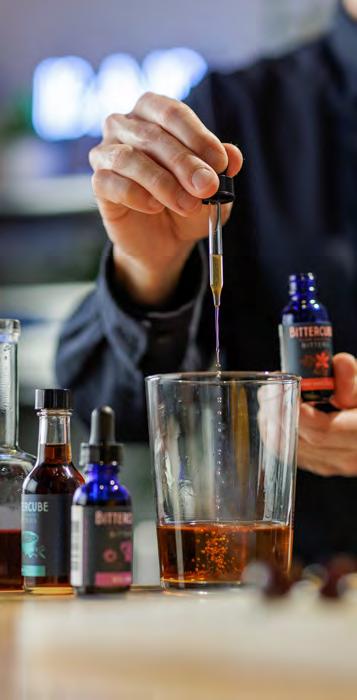


APRIL 2023 WHAT’S AHEAD THIS BASEBALL SEASON? What’s SPORTS SPONSORED BY PAGE 34 JUDGE JANET PROTASIEWICZ for WISCONSIN SUPREME COURT PLEASE VOTE ON APRIL 4 PLEASE VOTE ON APRIL 4 THIS ELECTION WILL DETERMINE THE FUTURE OF WISCONSIN ENDORSEMENTS PAGE 6


SPONSORED BY
PUBLISHER & EDITOR-IN-CHIEF: Louis Fortis (ext. 3802)
GENERAL MANAGER: Kevin Gardner (ext. 3825)
MANAGING EDITOR: David Luhrssen (ext. 3804)
BUSINESS MANAGER: Peggy (ext. 3832)

EVENT COORDINATOR: Jan Bruder (ext. 3810)
ACCOUNT EXECUTIVES: Bridgette Ard (ext. 3811)

Petra Seymore (ext. 3828)
Tyler R. Klein (ext. 3815)
SALES MANAGER: Jackie Butzler (ext. 3814)
BUSINESS DEVELOPMENT MANAGER: Chuck Hill (ext. 3822)
IN MEMORY OF DUSTI FERGUSON (OCTOBER 18, 1971 – NOVEMBER 20, 2007)
WEBMASTER: Barry Houlehen (ext. 3807)


DIGTAL STRATEGIST: Allen Halas (ext. 3803)
STAFF WRITER & CIRCULATION COORDINATOR: Blaine Schultz (ext. 3813)
INTERN: Sabrina Rosler
Layout and design by WaterStreet Creative.
FOR MORE UNIQUE CONTENT, VISIT SHEPHERDEXPRESS.COM.
Distribution: New issues of the Shepherd Express magazine are on the street, on the first Wednesday of each month, free of charge. The Shepherd Express may be distributed only by authorized distributors. No person may, without prior written permission of the Shepherd Express, take more than one copy of each monthly issue. Mail subscriptions are available. No refunds for early cancellations. One year (12 issues) via First Class mail: $100.00.
207 E. Buffalo St., Suite 410, Milwaukee, WI 53202

Phone: 414/276-2222 Fax: 414/276-3312
Advertising Inquiries: jackie@shepex.com
e-mail: info@shepex.com
URL: shepherdexpress.com
SHEPHERD EXPRESS MAKES NO REPRESENTATIONS OR WARRANTIES OF ANY KIND, WHETHER EXPRESSED OR IMPLIED, REGARDING ANY ADVERTISING. DUE DILIGENCE IS RECOMMENDED BEFORE ENTERING INTO ANY AGREEMENT WITH AN ADVERTISER.SHEPHERD EXPRESS WILL NOT BE HELD LIABLE FOR ANY DAMAGES OF ANY KIND RELATING TO ANY AD. PLEASE CHECK YOUR AD THE FIRST DAY OF PUBLICATION AND NOTIFY US OF ANY CHANGES. WE ARE NOT RESPONSIBLE FOR ERRORS IN ADVERTISING AFTER THE FIRST DAY. WE RESERVE THE RIGHT TO EDIT, REJECT OR RECLASSIFY ADVERTISEMENTS AT OUR SOLE DISCRETION, WITHOUT NOTICE. WE DO NOT KNOWINGLY ACCEPT ADVERTISEMENTS THAT DISCRIMINATE OR INTEND TO DISCRIMINATE ON ANY ILLEGAL BASIS, OR ARE OTHERWISE ILLEGAL. NO REFUNDS FOR CANCELLATION AFTER DEADLINE, NO COPY CHANGES EXCEPT TO PRICE OR TELEPHONE NUMBER.

46 70 NEWS 06 Please Vote on April 4 13 This Modern World 14 Remember When We Used to Encourage Our Children to Read Lots of Books — Taking Liberties 16 Beware the 'Socialist' Label — Issue of the Month 18 Shy McElroy Engages Parents of Kids with Lead Poisoning to Address the Lead Crisis — Hero of the Month 20 David Bowles Markets Diversity — MKE SPEAKS: Conversations with Milwaukeeans FOOD & DRINK 24 Kin Brings Modern Asian Dining to Downtown Wauwatosa 26 Squash and Pepper Magma — Flash in the Pan 28 The Rise of Bittercube Cocktail Bitters — Beverages SPECIAL SECTION 30 Earth Day 30 Eating for the Planet 34 Sports 30 What's Ahead This Baseball Season 38 Health & Wellness 38 What's Your Poison? — True Health 40 Sugar Maple's Delta-9 Cocktails an Alternative to Alcohol — Cannabis 44 Sexual Health: Deeply Rooted in Our Communities — True Health 46 Health Anxiety Hurts — Out of My Mind 48 Personal Finance 48 'Pay Yourself First' and Other Lessons in Personal Finance 50 Home & Garden 50 Exploring Frank Lloyd Wright's Burnham Block — Open House 54 Soil Health for the Home Garden CULTURE 56 Jewish Museum Milwaukee's 'Degenerate' 58 MSO's Ken-David Masur 62 This Month in Milwaukee HEAR ME OUT 66 No Such Thing as a "Little" Toxic — Dear Ruthie 68 The LGBTQ Day of Silence: Is it Finally Time to Speak? — My LGBTQ POV ART FOR ART'S SAKE 70 From the City that Always Sweeps
SPONSORED BY
SCAN ME
50 18 4 | SHEPHERD EXPRESS
COVER: Janet Protasiewicz for Wisconsin Supreme Court. Photo courtesy of Janet for Justice. Baseball season illustration by Tim Czerniakowski.


APRIL 2023 | 5
Please Vote on April 4
THIS ELECTION WILL DETERMINE THE FUTURE OF WISCONSIN
BY THE SHEPHERD EXPRESS EDITORIAL BOARD
JUDGE JANET PROTASIEWICZ FOR WISCONSIN SUPREME COURT JUSTICE

Spring elections are local elections for city, village, town or county offices along with judicial elections, school board elections and any special elections to fill vacancies. These are non-partisan elections meaning that candidates run as individuals and not on a party ticket.
The April 4 election is very important for the future of Wisconsin. The State Supreme Court election will determine the direction of Wisconsin for the next 10 years, including whether women will have full access to reproductive choices including abortions. After the retirement of one of the farright justices this year, the court will have three conservative and three progressive justices.
With a new progressive justice, the court will also be able to decide whether Wisconsin will continue to have honest and
fair legislative districts not the unconstitutionally gerrymandered legislative districts as they were declared by a conservative three-judge federal judicial panel.
Our unconstitutionally extreme gerrymandered districts enable one party to win the vast majority of the legislative races even when they received less than half of the total statewide votes for legislators. This is why Wisconsin, which had a national reputation for being a smart, forward-looking state, has fallen toward the bottom of the lists along with Alabama and Mississippi in such areas as education, fair taxation, equal opportunity to vote and protecting our children and senior citizens. These extreme gerrymandered districts enable the legislators to ignore the wishes of their constituents since it is virtually impossible for them to lose in their gerrymandered districts.
Photo courtesy of Janet for Justice.
6 | SHEPHERD EXPRESS NEWS
The Editorial Committee of the Shepherd Express is unanimous in its endorsement of Judge Janet Protasiewicz for Wisconsin Supreme Court Justice on the April 4 2023 election. Her values are strong support for women’s reproductive rights and fair legislative districts, boldly stating that the current gerrymandered Wisconsin legislative districts are rigged. Spring elections are lower turnout elections, so it is important to vote. Supreme court elections are non-partisan, but the two sides certainly have their candidates.
Right now, the seven-person court is divided 4-3 with the rightwing in charge. This conservative majority has, for example, condoned our extreme gerrymandered legislative districts, supported, at every opportunity, all the anti-choice abortion legislation, and supported the voter suppression laws pushed by Republicans denying our citizens an equal opportunity to vote.
VOTERS CAN CHANGE THIS ON APRIL 4
Wisconsin has a chance to change the direction of our extreme rightwing Supreme Court this Spring. One of the conservative four is retiring so the direction of the court is in the balance. This upcoming election is without question the most important election for Wisconsin to begin to return our state to the honest, decent, progressive state we grew up in.
ENDORSEMENTS
Wisconsin was always viewed as a forward-looking state with a great education system from kindergarten through post graduate work. Wisconsin was a state that protected our natural environment, helped foster the creation of well-paying, safe, and decent jobs, and cost-effective laws that protected our most vulnerable.
SO WHAT HAPPENED TO WISCONSIN?
That all changed over the past 15 years. The extreme rightwing Bradley Foundation along with an assortment of rightwing billionaires like the Koch Brothers decided to use Wisconsin as an experiment to turn our state into an ignorant, low wage, backward-looking state putting Wisconsin shoulder to shoulder with Alabama, Mississippi and West Virginia.
One of the key parts to their strategy was to pump millions of dollars of dark money funneled through shell companies with very high-sounding patriotic names into the Wisconsin Supreme Court races. Unfortunately, it worked. Through false and negative ads and in the Gableman race, overtly racist ads, they were able to elect a majority of extreme justices who put their rightwing politics above the Wisconsin constitution.

RESTORING WISCONSIN’S VALUES
That could change this spring with the election of a smart, hardworking, honest judge to the Wisconsin Supreme Court. Judge Janet Protasiewicz is Wisconsin. She worked her way through UWM and Marquette Law School. She chose public service over much higher paying private law firm positions. Judge Protasiewicz served as an assistant district attorney for 26 years and then eight years as a Milwaukee County Circuit Judge. She taught at the Marquette Law School as an adjunct law professor. We have watched her career for the past 34 years. We know her values and her respect for an honest interpretation of the state constitution, and we are totally confident that she would be a great Wisconsin Supreme Court justice.
Please vote for Janice Protasiewicz on Tuesday April 4.
APRIL 2023 | 7
JODI HABUSH SINYKIN FOR STATE SENATE
The Shepherd Express enthusiastically endorses Jodi Habush Sinykin for State Senate to represent the Northshore and surrounding communities. This district has been represented by Alberta Darling for the past 30 years until she retired in December 2022. Darling was first elected to the State Senate in the Fall of 1992 running as a very moderate Republican who proudly listed her membership in Planned Parenthood of Wisconsin in her resume. It was very sad and disappointing to watch her slowly move to the extreme right of her party including voting anti-choice in order to please her party leadership and to hold on to her committee chairmanships.
Jodi Habush Sinykin would be a fresh start for the residents of this state senate district. She is strongly prochoice on women’s reproductive issues which is in sync with both her district and the majority of people in Wisconsin. Habush Sinykin was born and raised in the district. Left for college and then Harvard Law School. She declined the highly paid opportunities to join the Wall Street and other East Coast law firms to instead return to Wisconsin to focus primarily on public interest legal work.
CONSENSUS AND COALITION BUILDER
Habush Sinykin is a consensus and coalition builder, which is what we desperately need in Wisconsin and the nation. Her legal positions often had her at the Capitol working both sides of the aisle. She worked on numerous issues but was most recognized for her work on environmental issues and humane animal treatment. Habush Sinykin was absolutely instrumental in securing Wisconsin’s support for the Great Lakes Compact, which was an international agreement with the U.S. Great Lakes states and Canadian provinces. This was once in a generation legislation that will protect our freshwater for generations to come.
Perhaps her greatest victory in the struggle for Humane Animal Treatment was helping to pass the Puppy Mill Law. This legislation ended the inhumane treatment by the greedy owners of the then unregulated breeding operations in Wisconsin.
If elected, beside fighting for women’s reproductive choice, environmental protections and humane animal treatment, Habush Sinykin would also focus on safe communities by fighting for more state shared revenues to adequately fund our local law enforce -

ment, which would lessen that burden on the property tax. She will also focus on the state’s economy. She has been a business owner and understands what small businesses need to flourish. Jodi would work across the aisle to develop legislation that would be bipartisan so it can pass both chambers of the legislation and also be signed into law by the governor. She is definitely not interested in posturing, instead she wants to see results that improve the lives of Wisconsinites.
Please Vote for Jodi Habush Sinykin for State Senate.
MOLLY GENA FOR MUNICIPAL JUDGE
The Shepherd Express enthusiastically endorses Molly Gena for City of Milwaukee Municipal Judge. Gena is very well qualified for the position having spent more than 15 years as a legal aid attorney serving over 1,700 clients in 45 different municipal courts and 23 circuit courts around Wisconsin representing clients who could not afford an attorney. Most of her work was in Milwaukee Municipal Court.

If elected, Gena will fight to take reckless and dangerous drivers off the streets and hold them accountable for the threat they pose to our community.
She will also hold abusive and predatory landlords accountable for their actions that often puts tenant’s health and safety at risk. This is just partial list of the issues she would work on. Municipal courts deal with everyday problems that have effect on many of our lives. Her patience and temperament and her history of treating everyone with fairness, respect, and dignity makes her very well suited for the job of Municipal Court judge.
Please Vote for Molly Gena for Municipal Judge.
Photo courtesy of Jodi for State Senate/Doug Hyant.
Photo by Jocelyn Gallegos.
8 | SHEPHERD EXPRESS NEWS

REELECT CORY MASON RACINE MAYOR
The Shepherd Express strongly supports the reelection of Cory Mason for Racine Mayor. As mayor, Mason has worked tirelessly to reduce violent crime, grow the middle class, improve the health of the community and its residents. This is not just talk; there were real results.

With respect to violent crime, Mason worked with the school district and the county to create a Violent Crime Reduction Initiative. This worked and led to over 500 criminal arrests, but also and most importantly, built the partnerships in the community to help prevent crime before it happens. This includes investing in mental health services, youth programs and other violence reduction initiatives.
Mayor Mason has also focused on growing a stronger middle class through the GROW Racine Initiative which directly invests in its residents. Growing a stronger middle class by bringing more residents into the middle class requires working on many fronts which is what Racine is doing. Racine now runs the largest adult high school program in the state. They are building a health clinic and also run a summer youth employment program and have helped over 300 residents become homeowners.
Racine definitely needs Mason to continue and grow these efforts.

Please Vote for Mayor Cory Mason for Reelection on April 4.
VOTE YES ON REPEALING THE ANTI-CHOICE LEGISLATION
On the April ballot in Milwaukee County is a referendum on repealing the 1849 legislation that bans all abortions with the only exception, saving the life of the mother, which requires at least two doctors to attest to the fact that the mother’s life is at risk. Obviously, this is pre-Civil War legislation when voting in Wisconsin was limited to only white males.
This is an advisory referendum because Wisconsin does not have a binding
referendum provision. Just because this is advisory, please do not think this is not important. The anti-choice people will be coming out to vote since they are hyping this up on their networks. They definitely want to win this vote and argue that Wisconsin does not support choice. It is important that the people who believe in a woman’s right to choose vote on April 4 and continue to show that the people of Wisconsin do trust women to make their personal choices.
The ballot referendum reads as follows:
“Should Wisconsin Statute 940.04, which bans abortion at any stage of pregnancy without exception for rape, incest, or health of the patient, be repealed to allow legal access to abortion care?”
Please Vote Yes and Support a Woman’s Right to Choose.
WORK REQUIREMENT ADVISORY REFERENDUM
Republicans in the Legislature put this advisory referendum on the ballot for April. The referendum reads: “Shall able-bodied childless adults be required to look for work in order to receive tax-payer funded welfare benefits.” While this referendum is designed to seem like common sense to most voters, which it is; so why the need for it on the ballot? It’s actually a political ploy which tries to reinforce the conservative big lie that all of the people who are poor are poor because they are personally irresponsible. Studies show that these “irresponsible people”
are a very small fraction of the poor. Instead, the studies clearly show that it is our collective failure to provide lower skilled individuals with decent training and employment opportunities at a decent wage. It also functions as a dog whistle racist appeal which capitalizes on prejudice in color-blind language.
Three decades of research since work requirements came into vogue in the 1990s demonstrates that these work requirements do not increase employment long-term or reduce poverty. The one thing they do well is create barriers
that forces many in need of food security, health care, and other necessities to go without. Most people do not realize that the vast majority of people on public assistance already do work. However, they simply cannot obtain a job which raises them out of poverty and enables them to fed their families. The minimal wage in Wisconsin is still at $7.25 per hour set decades ago. I think that says it all.
With the way this referendum is written, we suggest that you simply ignore it.
Photo courtesy of Mason for Racine.
10 | SHEPHERD EXPRESS NEWS

MILWAUKEE SCHOOL BOARD ELECTIONS
There are there are five Milwaukee school board positions up in the April 4 2023 elections.
Three of the five positions have incumbents running for a second term. All but one of the four positions have contested elections. The two members of the board who are not seeking reelection are Board President Bob Peterson and Board Vice President Sequanna Taylor.
DISTRICT 1: MARVA HERNDON
The Shepherd Express endorses Marva Herndon for reelection to the Milwaukee School Board. Herndon was first elected in April 2019. She is a graduate of West Division High School (now Milwaukee High School of the Arts). During her four years on the board Herndon has been a strong leader insisting that MPS students have access to full time music teachers, art teachers, physical education teachers and librarians. She has worked closely with teachers and the MPS administration across the district to increase these important components of education for all students.
Herndon has been a strong promoter of schools encouraging children’s appreciation for the natural world, including the need for students to learn about climate justice, agricultural practices (think Vincent High School, River Trail Elementary) and how they can help build a sustainable world.
Herndon’s four daughters are MPS graduates and her grand children who live in Milwaukee are MPS graduates or enrolled in MPS. As a 40-year resident of District 1, she is well known as a strong advocate for the community and one who is not afraid to speak up about what needs to be improved.
All five of our endorsees are strong supporters of public schools and believe that public education is essential to strengthening our democracy. Yes, our public schools need improvements, but that is difficult to do with years of underfunding by the Republican dominated legislature, and the ongoing vilification of public schools and the teachers who work daily with our Milwaukee’s students.
DISTRICT 2: ERIKA SIEMSEN
The Shepherd Express supports Erika Siemsen for reelection to the Milwaukee School Board. Erika was an MPS elementary school teacher for more than 30 years and she brings that expertise to the school board. She is well versed in teaching reading, restorative practices, and need for schools to be welcoming places for all students, parents and families.
Siemsen graduated from UW-Milwaukee with a B.A. in elementary education and later received her Master of Arts degree from Cardinal Stritch University in the area of literacy reform. Siemsen is an expert in early childhood education, which is a key factor in improving students literacy and math skills. She is from a family of three generations of MPS graduates. Her granddaughter currently attends Milwaukee Public Schools.
DISTRICT 8: MEGAN O'HALLORAN
Megan O'Halloran does not have an opponent in her reelection and that probably says all we need to say; however, if she did have an opponent, the Shepherd would almost definitely be endorsing her. Megan is a strong supporter of public schools and works closely with the schools in her Bayview/ Southside district. A few years ago she led a walk to the state legislature in Madison highlighting the need for adequate funding for all public schools. She is a strong advocate of parent involvement in MPS. Her two children attend Cooper Public School.
DISTRICT 3: GABI HART
The Shepherd Express strongly endorses Gabi Hart for election to the Milwaukee School Board District 3. Hart is a community activist who has focused on youth organizing work. She believes strongly that programs must serve all children. Hart will be a hardworking bridge builder, working collaboratively within the community to get things done for the children of Milwaukee. Among her many accomplishments, she co-led the Program in the Parks in Sherman Park after the conflict there a few years ago.
CITYWIDE DISTRICT: MISSY ZOMBOR
The Shepherd Express enthusiastically endorses Missy Zombor for the Citywide District. Zombor is an education, community and labor activist who is passionately committed to public schools. Her son attends a Milwaukee middle school, and she is marketing director for Rethinking Schools which promotes the importance of public schools and racial and social justice in schools. Zombor has previously worked communications director for the Milwaukee Teachers’ Education Association, the largest educators local in the state of Wisconsin. There she helped fight back a Republican-backed state takeover of Milwaukee Public Schools and supported resolutions for more nutritious food, longer recess, and smaller class sizes for students in early grades.
She is running for the position from which Bob Peterson is stepping down. Peterson has also endorsed her saying, “Missy is a smart hard-working and experience MPS parents and public education champion committed to defending and improving our schools.”
12 | SHEPHERD EXPRESS NEWS






APRIL 2023 | 13
Remember When We Used to Encourage Our Children to Read Lots of Books
BY JOEL MCNALLY
It seems so quaint now. There was a time in America when an important rite of passage was when parents took their children to a public library to get their own library cards.
It would open up fascinating new worlds to children far beyond their own immediate circumstances. That was especially important growing up as I did in a small town in Indiana that always seemed far away from anything very interesting.
Learning to read is the most important educational gift we ever receive. It leads to everything else we will ever learn for the rest of our lives.
Among all the dangerous political hatred now being perpetuated by rightwing Republican extremists, one of the very worst is their escalating attempt to demonize what once were among the most respected professions in every community – schoolteachers and librarians.
WHEN SCHOOLS BECOME BATTLEFIELDS
Slashing taxpayer funding for public schools was always a primary goal of anti-tax Republicans, but that’s become something far more sinister since Donald Trump openly attracted violent white supremacists into the Republican Party. Schools and libraries have become ideological battlefields where Republicans are trying to rewrite history by rolling back racial progress for Black and Brown communities and equal rights under the law for LGBTQ Americans.
The American Library Association (ALA) reports unprecedented threats to ban books from schools and libraries fueled by a blend of hard-right politics and Christian nationalism. Increasingly, it’s backed up with death threats and harassment against teachers and librarians labeled as “smut peddlers,” “groomers” and “pedophiles.”
“It’s time to understand that they’re serious about suppressing information and taking away people’s civil liberties based on their identity and race. They want to go back to 1952,” said
Deborah Caldwell-Stone, the director of the ALA’s intellectual freedom office. “We’re being confronted with the potential for another McCarthy era where people’s lives are ruined simply because of what they believe and who they are.”
In 2021, there were at least 729 attempts to remove 1,597 books from schools and libraries, the most recorded in 20 years of ALA record-keeping. The numbers in 2022 will be even higher. After eight months last year, the partial tally was already 681 attempts to ban 1,650 books.
The Top 10 list of the most banned books in America tells you everything you need to know about who’s behind it. It’s literally a checklist of books about everyone hard-core rightwing Republican extremists target with their virulent political hatred.
BAN ‘TO KILL A MOCKINGBIRD’?






The most banned book in America is Gender Queer, a memoir written in the form of a graphic novel by cartoonist Maia Kobabe about her adolescence coming out as gender nonbinary and asexual. Many adults have actually read many of the others including To Kill a Mockingbird by Harper Lee, The 1619 Project by Nikole Hannah-Jones, The Bluest Eye by Nobel-winning-writer Toni Morrison and Maus, another graphic novel about the Jewish holocaust by Art Spiegelman.

AMONG ALL THE DANGEROUS POLITICAL HATRED BEING PERPETUATED BY RIGHTWING REPUBLICAN EXTREMISTS, ONE OF THE WORST IS THEIR ESCALATING ATTEMPT TO DEMONIZE WHAT ONCE WERE AMONG THE MOST RESPECTED PROFESSIONS IN EVERY COMMUNITY— SCHOOLTEACHERS AND LIBRARIANS.
Illustration by Maria Petrishina/Getty Images.
NEWS TAKING LIBERTIES 14 | SHEPHERD EXPRESS
Those five books sum up the political hatred of far-right Republicans for LGBTQ Americans, equal treatment under the law for Black and Brown Americans and educating children about America’s racial history, the horrific rape and torture of American slavery and the only attempt by a fascist government in world history to exterminate the Jewish people through mass murder.
Republican eagerness to ban all those books will fail miserably as it should. Banning books is the worst
possible way to keep anyone from reading them. It increases the number of readers who seek them out. Republicans should have listened to their old speeches about America being the greatest democracy on Earth.

Their defeated ex-president did more than anyone to remind every American about the importance of protecting our precious freedoms. He did it by appointing a lawless majority to the U.S. Supreme Court that suddenly abolished 50 years of Constitutional rights for women to make their own decisions about their bodies, their health care and how many children to have.
CAN ANYONE FEEL SAFE?
If American women, more than half the population of the United States, can suddenly be stripped of their rights under the law to make decisions about their own lives, how can anyone else feel safe? That’s especially true for racial and religious minorities who continue to face murderous hatred in this country.
Americans will not willingly give up their Constitutional freedoms. A bipartisan majority in both houses of Congress passed Wisconsin Sen. Tammy Baldwin’s Marriage Equality Act codifying into federal law previous Supreme Court decisions legalizing marriage rights for same-sex and interracial couples.
Americans will continue to fight to protect their rights in our democracy to learn the real history of America and read any books they want about their own lives. Every two years, they will be joined by millions more young voters who are already fighting Republican book bans and destruction of college preparatory classes in American history.

Trumped-up Republicans ignore American voters at their own peril.
Joel McNally was a critic and columnist for the Milwaukee Journal for 27 years. He has written the weekly Taking Liberties column for the Shepherd Express since 1996.
“IT’S TIME TO UNDERSTAND THAT THEY’RE SERIOUS ABOUT SUPPRESSING INFORMATION AND TAKING AWAY PEOPLE’S CIVIL LIBERTIES BASED ON THEIR IDENTITY AND RACE.”
APRIL 2023 | 15
BEWARE THE ‘SOCIALIST’ LABEL BEWARE THE ‘SOCIALIST’ LABEL BEWARE THE ‘SOCIALIST’ LABEL
BY BILL HOLAHAN
We know one thing for sure about the 2023–24 election cycle: Republicans will label Democrats and their policy proposals as “socialist,” one of the most successful one-word epithets in the arsenal of political opposition rhetoric.
WHY IS THE SOCIALIST LABEL SO EFFECTIVE?
Socialism is an economics concept: an economy in which the means of production and distribution are owned and managed collectively through state, local and centralized government. The socialist label gains its persuasive power not from economic logic but through fear. The label conjures up an image of a bygone economic system that no one is proposing: Soviet-style economy-wide socialism and the accompanying bread lines, job assignments, and gulags for dissenters.
By contrast, modern economies are comprised of a mix of sectors. Some of these are private sectors, consisting of privately-owned firms with key decisions made by entrepreneurs and investors guided by market forces, especially the price system. Individual entrepreneurs and investors own the means of production, and they make decisions to make themselves better off, usually measured in profit. Examples are numerous, from car manufacturing to groceries, from restaurants to oil companies. As economist and philosopher Adam Smith proposed and experience has verified, when certain pre-conditions are present, most importantly competition, profit-seeking can serve the public interest even though that is not the goal of the profit-seeker.
Other sectors are public, organized by government authorities who are chosen by election, appointment, or other means of selection and succession. In a public sector, the means of production are owned by some level of government (national, state or local). Here, too, examples are all around us, from streets and roads to police and military protection, to the patent system, to contract enforcement.
PUBLIC/PRIVATE COMPLEMENTARITY
To function properly and efficiently, private sectors require publicly provided assets, services and institutions that complement market activity. Chief among these is the “rule of law,” i.e., rule-making and court-enforcement, such as property rights, contract and criminal law, and trade law and well-functioning police, fire fighters and military services. The public sector physical assets—commonly called “infrastructure”—must be kept in good working order to support the efficient operation of the market system.
The challenge of economic organization is to determine task-by-task, sector-by-sector, whether ownership of the means of production should be private or public and whether the allocation of resources within each sector should be directed by market forces or by the public sector.
TWO MARKET FAILURES; TWO PRO-MARKET CORRECTIVES
Consider two areas of great policy interest: infrastructure investment, and carbon pollution that contributes to global temperature increases. In each of these cases, the pre-conditions for unregulated market efficiency is missing; public intervention is needed to correct the market failure.
INFRASTRUCTURE INVESTMENT
Infrastructure assets, such as roads, sewer and water systems, rural broadband and school buildings, enhance the performance of the market system, and yet the market will not provide them. The public sector that builds, maintains and repairs the infrastructure of the state, local or national jurisdictions can be financed in a variety of ways, usually called taxes and user charges. This public investment is needed to support the market system, a complementarity that is a natural part of capitalism and should not be mistaken for “socialism.”
CLIMATE CHANGE
When fossil fuels are used in manufacturing, agriculture and transportation, or in commercial and residential structures, market forces will not naturally require users to pay one very real cost: the damage caused by the dumping of carbon into the atmosphere. Consequently, the market price of fossil-based energy is artificially low, and this energy source is overused and over-produced. Recognizing this, economists have for years proposed the imposition of a user tax on carbon emissions. With such a carbon tax, both consumers and producers will have an incentive to substitute less carbon-intensive products, a key first step in addressing this long-neglected threat to the human habitat on the planet.
The natural resistance to a new, pervasive tax such as one on carbon can be moderated by including in the proposal a rebate of the tax revenue raised: a “carbon dividend.” The Treasury Department’s Office of Tax Analysis estimates that a $40 per ton rebate would generate roughly $2,000 per year for a family of four, approximately 9% of the income for those who fall into the
NEWS ISSUE OF THE MONTH 16 | SHEPHERD EXPRESS
lowest income decile. In other words, while the world would gain some future relief from climate change, the poorest citizens would gain a significant immediate monetary boost derived from the policy that makes that future benefit possible.

To implement this carbon-tax/rebate plan, a government agency is needed to measure emissions, apply the tax, collect the revenue, distribute the dividend, and enforce the law, once again: not to be confused with socialism.
As these two examples show, it is illogical to affix a pejorative to public activity that enables the economy to work better. It is important not to conflate socialism with the public sector of a capitalist system.

Bill Holahan is emeritus professor and former chair of economics at the University of Wisconsin-Milwaukee. An earlier version of this article was posted on Econ4Voters at grassrootsnorthshore.com.

APRIL 2023 | 17
Shy McElroy Engages Parents of Kids with Lead Poisoning to Address the Lead Crisis
BY ERIN BLOODGOOD
As a child, Shy McElroy fondly remembers playing in the field outside her childhood home on 11th and Burleigh. All the kids on the block would come play in the dirt or in the winter, they would make snow angels and snowmen. When she had her son, Nathan, he would play in that same field.
It wasn’t until her son was five years old that she realized he was being poisoned by the lead paint littering that field. She remembers the landlord who owned the house on the other side of the field painting his siding with white paint multiple times. That paint—as well as paint inside her house—was lead-based and a serious health risk.
“My son used always reach up on the windowsill and pull himself up and when I would come home from work, he would be like, ‘Mommy! Mommy!’” McElroy smiles when she recalls that memory, but her mood quickly shifts when she remembers him putting his hands in his mouth after being covered in lead dust from the windowsill.
When McElroy first brought her son home from the hospital, his medical tests showed lead levels in his blood, but she had no idea what that meant and no one, including her doctors, explained it to her. “There were so many things that could have happened to prevent it from getting worse,” she said. “It was not an emergency for my child. It was treated as if he could drink more orange juice and he would be okay.”
COGNITIVE IMPAIRMENT
It wasn’t until her son was five that she realized how this was impacting his cognitive abilities and behavior in school. By that point, the lead in his blood was significantly higher and his preschool teacher was suggesting he repeat that year of school.
McElroy never wants to see a lack of education, resources, and most importantly, a lack of urgency be the reason parents don’t take immediate action to protect their child from being lead poisoned.
In 2018, she began working with the Coalition on Lead Emergency (COLE) when a group of community members
 Photo by Erin Bloodgood.
Photo by Erin Bloodgood.
18 | SHEPHERD EXPRESS NEWS HERO OF THE MONTH
came together to address the lead crisis in Milwaukee. She now leads the working group called COLE Parents Lead (along with Deanna Branch and Maria Beltran), which educates and engages parents whose kids are lead poisoned.
When parents first come to COLE looking for help, the group offers a twoday training session to teach parents about lead exposures in paint, water and soil, how good nutrition can help fight lead poisoning, and the health impacts of lead. They also teach the parents how to have a conversation with other people who may not know about the risks of lead.
Then they pay parents to help run food drives for the public where they offer nutritious food to the community, hand out their lead-safety kits, and offer lead testing. McElroy says that many of these families have never been tested for lead and roughly 95% of them are finding out for the first time that they have been lead poisoned.

When she started working with COLE, McElroy says there were eight families involved, but now there are over 200 families engaged in the work, and the group has helped over 600 families. Those families meet every month to decide next steps and how they can organize to have more of an impact, such as speaking at public hearings, doing house calls to help families install water filters, and building a trusted relationship with the health department.
COLE has gained serious momentum in the last five years to address this health emergency and they are not slowing down. “The only way that we build a better future is to stop the problem now. If we spend money now to fix the problem, we’ll save money in the future on cleaning it up,” McElroy says. She’s fighting every day to prevent the next generation of kids from being lead poisoned and wants parents to know she is here to support them.
 Learn more about the Coalition on Lead Emergency at coalitiononleademergency.org.
Learn more about the Coalition on Lead Emergency at coalitiononleademergency.org.
APRIL 2023 | 19
Erin Bloodgood is a Milwaukee photographer and storyteller. See more of her work on her website at bloodgoodfoto.com.
David Bowles Markets Diversity
BY TOM JENZ
At only 31, David Bowles is a business success story. As president of the CMRignite marketing agency, he leads his 65 employees in creating social impact programs for government agencies, nonprofits, and private companies. He leads by example, his staff equally divided among whites, Blacks, Latinos, and Asian Americans.

David Bowles comes from an upper middle-class family of four. When he was a small boy, his mother, Jacqueline Moore Bowles, founded CMR, hired three people, and built the marketing agency from scratch. From kindergarten through the 12th grade, he attended the private University School of Milwaukee. He played sports and was involved in student government. “It was a good school,” he said, “but I wish I could have experienced a little more diversity.”
I met Bowles in the sprawling CMRignite conference room with a bank of windows offering a dramatic view of Downtown. His enthusiasm is catching, and he speaks of his company like a coach inspires a football team.
After University School, you ended up at the Ivy League Columbia University in New York City. What was that like for you?
I went to Columbia because I wanted a totally different situation than how I grew up. I was raised in a non-diverse suburban experience. Columbia is a diverse urban experience with 50% students of color and in the heart of downtown New York. I wanted discomfort. That’s how you grow. It was the hardest, most stressful time in my life, but it was amazing to be performing at a high level, competing with the smartest kids in the nation. My major was financial economics. I love macroeconomics, the national or global scale of economics—the Fed moving interest rates, fluctuating employment rates, international money policy.
After college, did you start right away working for your mother at CMR?
I started working at CMR while I was still in college. My mom was able to obtain a nine-year certification that allowed CMR to qualify for certain Federal government contracts. While still in college, from 2010 to 2013, I’d
travel to Washington D.C. for CMR. At 19, I was pitching new business, and I was able to win a number of government contracts. Not long after college, I came back to Milwaukee to join the company.
You are now president of CMRignite, one of the nation’s leading minority-owned social impact marketing agencies. After joining the company as director of business development, you worked your way up to the top over the years. How did that transpire?
When I joined the company in 2010, we had four employees. In 2014, I moved back to Milwaukee to work full time at CMR, basically to run the company. We were still pretty small. My mom acted as my collaborator. I learned the business from the ground floor on up. I watched her handling clients, coaching employees, motivating people. I learned how to be a leader. I worked 60 hours per week. From 2014 to 2021, we built up the company to 65 employees. I became President in July 2021.
Let’s talk specifics. I found this on your website, and I quote,
Photo by Tom Jenz.
20 | SHEPHERD EXPRESS NEWS MKE SPEAKS: CONVERSATIONS WITH MILWAUKEEANS

“CMRignite is a full-service, strategic communications agency that specializes in developing cause and behavior change marketing for Fortune 500 companies, major nonprofits and government agencies.” Can you expand on this further, maybe give an example or two of how you are strategizing with your clients?
We don’t sell iPhones or new cars. We focus on how to use behavioral science to drive impact. For example, we do work for the government in the area of COVID vaccines. Our job is to show African Americans how the vaccine is made and provide them with information to make a decision on whether to take the vaccine. We do this through traditional advertising—TV ads, radio, billboards and so on. Our goal is to understand how people think and what motivates them to certain behaviors. We encourage our clients to understand their clients’ behavior patterns, what they value and believe, and what they fear. We try to craft messages that speak to their customers’ behavior patterns. For example, the anti-tobacco campaign: We start by asking why does someone smoke, and then compare the value they get from not smoking. We try to help change overall customer behavior. We act as our clients’ consultant.
Are your clients involved in social causes—nonprofits and government agencies, for instance?
We work primarily with government agencies. But we have worked with GE, Northwestern Mutual and other private corporations or their foundations. It’s usually about corporate social responsibility, environmental, social and government. We focus on social causes, like diversity, health, and environmental issues.
Your company works through what you call the Total Marketing Model. You have conducted business with notable national clients, like GE Healthcare, UW-Madison and the Air National Guard. What exactly is the Total Marketing Model?
The Total Marketing Model is a marketing ideology that looks at combining the needs of white consumers with multi-cultural consumers—that kind
of broad spectrum. We provide key information as to where the white and multi-cultural sectors overlap. Our CMRignite staff is made up of 25% each of white, Black, Latino, and Asian-Americans. We’ve brought together employees who look different and have different experiences. We have the perspective to create an ad campaign that reaches both rural white folks and urban African Americans. This inclusivity approach is the Total Marketing Model. That is what we do for our clients.
Criminal activity and violence have been major problems in Milwaukee, especially in the central city occupied by mostly Black residents. I understand that CMRignite is helping to address violence. To quote you, “As a proud Milwaukee native, I’ve seen the irreversible impact of gun violence and have watched it destroy too many of our neighborhoods, our communities and our families. From the Central City to the Deer District, we’ve lost too many lives to this epidemic. It’s time for bold ideas and bold actions, and I’m hopeful that CMRignite can be a part of the solution.” How is your company helping to reduce violence? Violence is a huge issue, especially gun violence. Unfortunately, I hear a lot of empty words from people in positions of power about lowering violence. I don’t see them putting their money where their mouths are. At CMRignite, we did not ask for government or non-profit funding. We made a sizable investment of our own money and conducted surveys of Milwaukee residents to find out how they see the violence problem. Too often, leaders and bureaucrats tell residents what the problems are, and do not listen to them. We work with Antonia Drew Norton and The Asha Project. One of our programs is We Are Here, which supports domestic assault survivors from culturally specific groups like Blacks, Native Americans, and Latinos. Often, victims of color don’t feel comfortable in similar programs tailored to the general market. We helped design and promote the We Are Here brand. Our goal is to provide services where survivors feel included and can be heard.
CMRignite’s Innovation Hub conducted a recent survey. The survey found that in Wisconsin, about seven in 10 African American and Hispanic residents say gun violence is the most important issue facing Milwaukee. That is a remarkable statistic if you compare it to the issues suburban white residents deal with. Can you comment on this? And what exactly is the Innovation Hub?
The Innovation Hub is our research team led by our senior research director, Heidi Tarr, MPH. We wanted to hear about the violence problem from the actual residents who live in those neighborhoods affected by violence, who live in a state of fear. The overall fear creates an unhealthy environment. How can you have a productive community in that kind of depressing environment? I’ve heard a lot from people who don’t live in these communities telling us what the problem is, and I don’t think that judgement is appropriate. Frankly, I am so tired of hearing that Milwaukee is the worst place for Black people to live. Too many in our community say they care about racial justice but aren’t doing much. People of color in Milwaukee want to have the problem of gun violence and criminal activity solved, and we’re committed to solving it.
You were recognized as one of Wisconsin’s most influential Black leaders in 2022. What does that mean for you and your company?
I think it means I have a responsibility to help create social change. My expertise is in communications. If I don’t use that expertise, then my name should be removed from the list.
You are still a young man. Do you have a long-term goal for your company?
My long-term goal is to be the nation’s biggest Black-owned marketing agency, while still remaining 100% committed to creating real social impact.
22 | SHEPHERD EXPRESS
NEWS MKE SPEAKS: CONVERSATIONS WITH MILWAUKEEANS
Tom Jenz writes Central City Stories for shepherdexpress.com.


Kin Brings Modern Asian Dining to Downtown Wauwatosa
Kin Brings Modern Asian Dining to Downtown Wauwatosa



 BY SUSAN HARPT GRIMES
BY SUSAN HARPT GRIMES
24 | SHEPHERD EXPRESS FOOD & DRINK
Photos courtesy of Kin by Rice n
Roll.
Wauwatosa’s village area has long been evolving into a “world foods” dining destination. Since 2019, Kin has been a part of that effort, offering wonderfully fresh modern Asian dishes including sushi and ramen. With a dining room that can seat upwards of 80 guests at a time, Kin is considerably larger than its sister restaurant, Rice n Roll Bistro, on Farwell Avenue. On a recent Saturday evening visit to Kin, nearly every table was filled, in addition to steady carry-out traffic, yet the staff had it fully in hand. Food was prepared beautifully and delivered to tables swiftly. Our server was knowledgeable about the menu, and very helpful in answering questions about dietary concerns.
There are several excellent ways to begin your meal at Kin. If you prefer more traditional openers, go with a steaming bowl of rich, flavorful Tom Kha soup ($5.50) with a creamy coconut milk base and chock full of mushrooms, cherry tomatoes, and scallions. The Crab Rangoon ($7) and Egg Roll ($7) are also quite good. One unexpected option, the Truffle Parmesan Fries ($12) topped with truffle oil, parmesan, and seaweed powder, served with spicy mayo, garlic mayo, and sriracha buffalo sauces were outstanding and didn’t seem at all out of place in a restaurant specializing in Asian dishes. There’s also a respectable list of a la carte nigiri or sashimi ($2.50-$4) from the sushi bar to round out the appetizers.
Entrees at Kin are separated on the menu by Thai Street Food, Chef Specialties, and Sushi Bar maki rolls. This arrangement lends itself quite well to ordering a few rolls and a dish or two for the table to split, but only if you can get your dining companions to agree
on which to choose. Standouts include the Jumbo Lump Crabmeat Fried Rice ($26) and its simplified cousin Garlic Fried Rice ($13) both of which are expertly seasoned with black pepper and garlic with the former including a generous portion of crabmeat. Another great dish is the Honey Roasted Duck ($17) perfectly prepared duck with a sweet honey sesame sauce, served with rice and steamed bok choy. Ramen bowls ($16-$17), which weren’t tried, appear to be interesting with tasty variations of classic flavors and ingredients.
Kin has an extensive list of maki rolls to choose from ranging from the simple ($7-$15) to the considerably more complex ($11-$20). One creative option, the zippy West Town roll ($18), features spicy tuna, spicy mayo, pepitas, jalapeno, Inari topped salmon with wasabi tobiko will warm you right up. Or go with something less spicy, but just as tasty, like the Demon Dancer ($18) featuring shrimp tempura, masago and avocado wrapped cooked shrimp, topped with sweet soy and ponzu. Whichever roll (or really any dish at Kin) you choose, it will arrive at your table so beautifully plated it will be almost too pretty to eat. Almost.
7484 W. State Street (414) 524-9056



kinbyricenroll.com
Handicap access? Yes
Reservations? Yes
$$-$$$
Susan Harpt Grimes is a food and features writer for shepherdexpess.com.
KIN BY RICE N ROLL
APRIL 2023 | 25
Squash and Pepper Magma
 BY ARI LEVAUX
BY ARI LEVAUX
Asauce called Magma made its debut at Thanksgiving dinner, 2022. As they passed the magma around the table, the revelers quickly noticed its power and utility. The crimson emulsion was like a second gravy for the turkey. Its sweet pungency enhanced the stuffing, which sounds impossible but it’s true. The potatoes, dressed in red, became all the more delectable, and the Midwestern casserole became downright edible. Someone at the table dubbed it red mayonnaise, because it improved everything it touched. After the meal there were so many leftovers that the hosts handed out full takeout containers to the departing guests. But they kept the scant remains of the Magma in a takeout container for themselves.
Like its namesake, Magma sauce comes from the earth, but the surface rather than the depths like true molten lava. Forged from roasted red peppers and baked squash, Magma imparts the sweetness of both, with a near-piquant undertone that makes you cringe like you’re about to get slapped, but it doesn’t deliver. Instead,you get kissed, with possibly a lipstick red mark left on your face. There are a few extra seasonings, but the peppers and squash dominate, and there is no need to complicate matters.
We owe the existence of Magma sauce to an arrangement my kids have with a local farmer. They sell his excess produce in a roadside stand and split the money. This year, after bringing home a literal truckload of squash and peppers, winter came unseasonably early. The icy conditions made it impossible to put the stand out. After six weeks of waiting for autumn to regress from the clutches of winter, we threw in the towel and donated the produce to the local homeless shelter in time for Thanksgiving. I hung onto a couple of boxes of each, for personal use.
On Thanksgiving morning, while my son made an angel food cake, I roasted red and yellow peppers and baked an orange kabocha squash that goes by the name Sunshine. I peeled the blistered peppers and scooped the squash flesh and combined these two ingredients in the blender with olive oil, garlic, salt and some thyme.
The resulting puree was thick, and after some time in the fridge grew downright stiff. It turns out that both squash and peppers contain pectin, a carbohydrate that jam makers use to thicken their product. Jeopardizing my precious Thanksgiving belly-space, I began eating my creation, heavily garnished with cilantro and green onions. I spooned it down like soup, not at all regretting the turkey I was forsaking. It was like eating a salad in a bowl of thick dressing, so tangy from the bell peppers that it didn’t need acid.
The day after Thanksgiving I made another batch, this time with some hot peppers. I spooned this red mayo upon scrambled eggs, where it looked and tasted like salsa, despite having no tomatoes. I tried some on pasta, where it was like a creamy marinara.
Since we had some leftover yolks from my son’s angel food cake I made mayonnaise and folded in some Magma. Although it was now a true red mayo, it had less charm than the original. The oil and yolks dulled the raw, vegetal flavors. And the original version was thick enough, thanks to the pectin. After an hour in the fridge the Magma is even thicker, so solid you can’t even pour it. You have to scoop it like pudding. And unlike its namesake, Magma sauce stays red, even when cool.
FOOD & DRINK FLASH IN THE PAN 26 | SHEPHERD EXPRESS
Photo by Nungning20/Getty Images.
Magma Sauce
The quantities listed here will make about a quart of magma. As a soup it serves four. As a sauce, a few more.
• A 3-lb. kabocha squash (or similar starchy winter squash)
• 8 bell peppers, red or yellow (the flavor is good with both, but the color is better with red)
• Optional: some hot peppers if you want more fire in the Magma
• 4 large garlic cloves
• 4 tablespoons olive oil
• 1 teaspoon thyme or oregano

• 1 teaspoon salt; more to taste
Preheat the oven to 375. Cut the squash in half, scoop out the seeds, and lay the halves down on a baking pan. Cook until soft enough to squeeze from the outside, about 45 minutes. In a separate pan roast the peppers, turning once or twice so they blister on both sides. Remove them after about 30 minutes, or when they are completely blistered and collapsed. At the same time, roast the garlic in the olive oil in a small oven-safe dish until soft—about 30 minutes.
Allow the roasted ingredients to cool. Peel the peppers as best you can—it’s OK if some bits of skin remain—and scrape out the seeds. Scoop out the flesh from the squash skin. Add the squash, peppers, garlic and olive oil, salt and thyme to a blender. Puree. Season with more salt if necessary. Puree again.
Your Magma sauce is now ready. Let the eruption of flavors begin.
 Ari LeVaux has written about food for The Atlantic Online, Outside Online and Alternet.
Ari LeVaux has written about food for The Atlantic Online, Outside Online and Alternet.
APRIL 2023 | 27
Photo by Ari LeVaux.
The Rise of Bittercube Cocktail Bitters
BY GAETANO MARANGELLI
Igot the news in Chicago from a master sommelier.
“Do you know about this new cocktail bitters company? They make their bitters using raw botanicals. No extracts. No flavorings. And they don’t make all of their bitters by infusing neutral spirits with a single ingredient. They create distinctive bitters by infusing brandy, rum and whiskey with a variety of ingredients. They’re called Bittercube, and they make their bitters in Milwaukee.”
That was more than 10 years ago. Since then, Bittercube has exploded nationally.
What exactly are cocktail bitters? And why is the quality of Bittercube worth looking for at their new shop in the North Avenue Market? Those are among the questions I asked Ira Koplowitz, the proprietor of Bittercube, and Brandon Reyes, Bittercube’s general manager.

WHAT MAKES BITTERCUBE WORTH YOUR WHILE?
How do you describe cocktail bitters to people who don't know what they are?
B.R.: We think of bitters as liquid spice blends, used for seasoning cocktails in a sense. Having a selection of different varieties of bitters can allow the drink maker to add, amplify, compliment and contrast certain flavors in a beverage.
I.K.: Bitters are liquid spice. Think of them as the spice rack for your home bar. Use them liberally, use them daily!
What is the origin story of Bittercube?
I.K.: Bittercube was founded in the fall of 2009, by myself and Nick Kosevich. We both worked at respected cocktail bars, Nick at Town Talk Diner in Minneapolis and myself at The Violet Hour in Chicago. We were creating bitters at the bars we worked at and saw an opportunity in the growing craft cocktail scene.
The two of us uprooted our lives and moved to Milwaukee to start Bittercube. We had little to no business experience but quickly made a name for ourselves by throwing kickass cocktail events around the city, and developing a lineup of bitters that would quickly put us on the national map. Within two years of forming the company, we had grown the distribution network for the bitters and were featured in the likes of the Wall Street Journal, Food & Wine magazine, Martha Stewart’s Everyday Food and Playboy
What qualities distinguish Bittercube Bitters from other brands of bitters?
B.R.: Many other brands focus on singular flavors, while ours are quite complex and have their own balance of flavors. We also hang our hat on the fact that we use only raw botanicals in our bitters as opposed to any extracts or flavorings.
I.K.: Most bitters use neutral spirit as the base, and while a few of our bitters
Photo courtesy of Bittercube.
28 | SHEPHERD EXPRESS FOOD & DRINK BEVERAGES
also use a neutral base, the majority of our products utilize whiskey, rum, and brandy as the base, which add complexity and depth. Rather than focusing on one ingredient, which is a common theme in the bitters world, we create distinctive bitters with an array of ingredients and flavors.
How would you encourage people to experiment with Bittercube Bitters?
B.R.: They might seem like a precious thing used only on special occasions, but we highly recommend frequent usage. Try them in everything from lemonade to cookies and marinades. As far as cocktails, try the less obvious pairings. Yes, cinnamon forward bitters are delicious with grapefruit, but so are root beer bitters.
Why would you encourage people to visit you at the new Bittercube shop at 5900 W. North Avenue or the flagship shop at 4928 W. Lisbon Avenue?
B.R.: If you’re wanting to learn more

about bitters and botanicals, the bartenders at the market are all happy to share more details about all of our products and demonstrate how to use them. All of the bitters are available for purchase at the bar as well.



I.K.: If you are looking for boozy ingredients, you should swing by the Bittercube Bar at North Avenue Market. There you can not only purchase Bittercube Bitters, but we also sell Heirloom Liqueurs, and a collection of unique spirits. If you are looking for non-alcoholic ingredients, come by Bittercube HQ, where we have Bittercube Bitters, cocktail gear, syrups, canned cocktails, et cetera.
Gaetano Marangelli is a sommelier and playwright. He was the managing director of a wine import and distribution company in New York and beverage director for restaurants and retailers in New York and Chicago before moving to Wauwatosa.
APRIL 2023 | 29
Photos courtesy of Bittercube.
Eating for the Planet
MILWAUKEE’S ABUNDANT OPTIONS FOR SUSTAINABLE SUSTENANCE
BY VIRGINIA SMALL
As we approach the 53rd anniversary of Earth Day, it’s not just coal-burning utilities and gas-guzzling vehicles heating up our planet. “All told, the food, agriculture, and land-use sector contribute 24 percent of anthropogenic greenhouse gas (GHG) emissions,” according to Project Drawdown, a leading science-based nonprofit advocating for climate solutions.
The good news is that we can participate daily in addressing the Earth’s climate crisis, regardless of situation or budget. “Shifting diets and addressing food waste can significantly reduce the global demand for food. Eating lower on the food chain and ensuring [that] what’s grown gets eaten is a powerful combination that lowers farming inputs, land clearing, and associated emissions,” according to Drawdown.
“Eating for the planet” is a multipronged process of climate-conscious choices. No one diet fits all. Nonetheless, it requires personal and collective commitments. Milwaukeeans have been building sustainable food networks for decades through farmers markets, co-ops, urban agriculture, and food-justice initiatives.
Eating engages the head and heart, and most of the senses. There are myriad ways to find joy in what and how we sustainably feed ourselves and others. Here are several:
Focus on real food. One definition of real food is that it is as close as possible to its natural state, and has not undergone intensive processing, been genetically modified, or is laden with chemicals. The more food is processed, the bigger its carbon footprint.

Real food offers other benefits in nutrients, flavor and connection. And frequently it costs less. We often are led to believe that eating real food is pricey. In fact, buying and cooking it can be done affordably. For example, scratch-made soups made with dried beans and fresh vegetables cost a fraction of equivalent amounts for processed soup. A crock pot or multicooker can reduce cooking times.
Do it yourself. Growing food satisfies on many levels. So does cooking and preserving. When gardening space is scarce, a porch or balcony can accommodate a few pots for herbs or veggies. Greater Milwaukee boasts many community gardens, with plots available for a modest fee. The University of Wisconsin Extension and the Victory Garden Initiative offer assistance with gardening techniques and logistics. The Extension’s FoodWise program works with local organizations to teach about affordably buying and preparing healthy food. Many organizations teach cooking and canning. Friends and family who cook are often eager to mentor others.
Look for locally grown food. Processing and long-haul transport of food increases its carbon footprint. More importantly, buying from local farmers and producers supports a resilient food system and economy. And the fresher the produce the longer its shelf life.
Outpost Natural Foods Co-op, a Milwaukee stalwart since 1970, stocks a high percentage of locally grown food (much of it organic) at its four locations. Beans & Barley and Riverwest Co-op also carry locally grown produce as do some supermarkets; if stores lack such sections, ask for them. Many restaurants source locally and identify providers.
Buy directly from farmers. Benefits from farmers markets include opportunities to form relationships with people who grow the food we eat. Shoppers with QUEST cards double the value of each dollar spent at farmers markets.
About 25 seasonal markets are held throughout greater Milwaukee. The Milwaukee Winter Farmers Market, located at The Table (5305 W. Capitol Drive), is held Saturdays, 9 a.m.-2 p.m. through April 29. Numerous community farms operate within greater Milwaukee.
In “community-supported agriculture” (CSA) programs, members assist farmers by purchasing a seasonal “share”
30 | SHEPHERD EXPRESS SPECIAL EARTH DAY
Photo by CharlieAJA/Getty Images.


APRIL 2023 | 31
of the harvest. Subscribers then enjoy weekly produce from a trusted source, often with flexible ordering options.
Compost. Whenever possible, transform food scraps into fertile compost. Or enroll in a program, such as Compost Crusader, a nonprofit St. Francis-based operation. Reducing food waste in landfills decreases GHG emissions.
Go organic. Organic agriculture relies on regenerative farming techniques instead of synthetic and petroleum-based pesticides and fertilizers. Organic methods reduce a farm’s carbon footprint.
Eat less meat, especially beef. Going meatless for even one day a week can make a significant impact. According to the World Resources Council (WRC), “Beef is more resource-intensive to produce than most other kinds of meat, and animal-based foods overall are more resource-intensive than plantbased foods. Beef requires 20 times more land and emits 20 times more GHG emissions per gram of edible protein than common plant proteins, such as beans.” Livestock production uses 70 percent of all agricultural land.
WRC elaborates: “If…meat consumption in high-consuming countries declined to about 50 calories a day, or 1.5 burgers per person per week … it would nearly eliminate the need for additional agricultural expansion and associated deforestation.”
Grass-fed meat and dairy create fewer environmental impacts. Fish and chicken, depending on sourcing, generally have smaller carbon footprints than meat.
Decrease dairy. Dairy production requires intensive land use and other inputs. It also releases high levels of methane, a GHG. When buying dairy products, choose grass-fed, organic, or ones without growth hormones and antibiotics. Or purchase vegan alternatives, including “milks” made from plants such as hazelnut and hemp, two sustainable Wisconsin crops. Note that cashew milk is more sustainable than almond milk, since almond trees require excessive water.
Broaden your food palate. Exploring new foods and dishes is a perk of sustainable eating. Milwaukee eateries offering tasty plant-rich items include many ethnic restaurants. Expand both culinary horizons and friendship circles by attending or hosting a plantbased or vegetarian potluck gathering. Friends of Real Food co-hosts a monthly potluck and program with the Urban Ecology Center in Riverside Park.
Clean Wisconsin, a nonprofit working to protect Wisconsin’s clean water, clean air, and natural heritage, champions lesser-known “climate-smart perennial crops” such as aronia berries, produced by a native shrub; Kernza®, a wheatgrass that grows sustainably; and hazelnuts. Clean Wisconsin also advocates for public policy supporting regenerative and restorative agricultural practices, including “agroforestry.”
Connect with others in communitysupporting foodways. An attitude of reciprocity is a cornerstone of Indigenous foodways. One meaningful way to begin meals is acknowledging the origins of that food, and how it was prepared. When sourcing is unknown, that can seed other conversations.
Many local groups host activities promoting sustainable food systems. Several local nonprofits provide settings where healthy food and belonging can be enjoyed by all. Tricklebee Café, a pay-what-you-can community café, serves vegan lunches four days a week and hosts food-related programs. Kinship Community Food Center (formerly Riverwest Food Bank) has developed a holistic approach to food security, wellness and belonging.
Taste of Lindsay Heights, owned and operated by the nonprofit Walnut Way, is a carry-out café featuring cuisine by budding Milwaukee entrepreneurs. Sherman Phoenix also hosts shared professional kitchen space for incubating local entrepreneurs. Alice’s Garden “provides models of regenerative farming, community cultural development, and economic agricultural enterprises.” Milwaukee Food Council supports a locally anchored food system that “advances Milwaukee’s social, economic, and environmental well-being through collective action.”
Patronize vendors who commit to sustainable practices. Plastic-Free MKE, a collaborative of organizations committed to reducing single-use plastics, has launched a “Lake-Friendly Business” program. Food-service businesses can join by instituting sustainable practices, including eschewing Styrofoam and plastic bags; providing reusable tableware and degradable straws and stirrers; using compostable to-go packaging; and following proper recycling practices. Encourage businesses you frequent to sign on.
Start where you are. After opening Amaranth Bakery and Café (3329 W. Lisbon Ave.) in 2006, Dave Boucher and Stephanie Shipley chose to “be incremental” in sourcing sustainable ingredients. “We’ve gradually been able to obtain all organic flours for what we bake, and we rely on varied sources of produce, including from our garden,” said Boucher. “We decided it was essential that we keep our prices affordable.”
An incremental approach also works for planet-conscious eating. Considering impacts of our personal decisions deepens our relationship with food and acknowledges interconnectedness. As we sustain new habits, we can move on to exploring others. With each meal we can interact with nature and foster greater health for ourselves, our community, and the Earth.
Virginia Small grew up on a Wisconsin farm where her family grew and preserved much of their food. After reading Diet for a Small Planet by Francis Moore Lappe in the 1970s, she committed to eating “lower on the food chain.” An award-winning journalist and former senior editor for a national gardening magazine, she is currently researching and writing about Wisconsin’s longtime leadership on environmental issues.
32 | SHEPHERD EXPRESS SPECIAL EARTH DAY



APRIL 2023 | 33
WHAT’S AHEAD THIS BASEBALL SEASON? This
BY KYLE LOBNER
When fans come out to American Family Field to watch the Brewers this summer there’s a good chance they’ll see an opponent they haven’t seen in a long time, if ever. Major League Baseball overhauled its scheduling format for the 2023 season, reducing each team’s number of games against divisional opponents and adding interleague games against every team, every season. Fans who attend games regularly won’t take long to notice the change: In 2022, 18 opposing teams visited American Family Field and the Car-
dinals, Cubs, Reds or Pirates were the opponent in almost half of Brewers home games. In 2023, 22 different teams will come to Milwaukee for at least one series and games against divisional opponents only make up a third of the home schedule.
Meanwhile, increasing interleague play will lead to more matchups that fans haven’t seen in a while. Here are some of the teams making trips to Milwaukee in 2022 for the first time in a long time:
34 | SHEPHERD EXPRESS SPECIAL SPORTS | SPONSORED BY POTAWATOMI HOTEL & CASINO
Illustrations by Tim Czerniakowski.
April 21-23: Boston Red Sox
Boston was one of the Brewers’ most frequent opponents when Milwaukee was still an American League city, but the Brewers and Red Sox have not crossed paths often since. This will be just the third time Boston is visiting American Family Field and only the second series since 2003. For the Brewers it’s a good time for this rivalry to resume: Since their last trip to Milwaukee the Red Sox have had a 108-win, World Series team in 2018 and a 92-win 2021 season, but they’ve taken a step back recently and are projected to be under .500 in 2023.

April 28-30: Los Angeles Angels
The Brewers and Angels met in one of the most famous baseball games in Milwaukee’s history, the fifth and final game of the 1982 ALCS where Cecil Cooper’s two-run single in the seventh inning sent the Brewers to their first and todate only World Series. There haven’t been many opportunities to relive those memories in recent years, however, as the Angels have come to Milwaukee just three times since American Family Field opened in 2001 and haven’t been there at all since 2016. This will be Brewers fans’ first-ever look at Shohei Ohtani and their first opportunity to see three-time AL MVP Mike Trout in seven years.
June 6-8: Baltimore Orioles
If the final game of the 1982 ALCS isn’t the most famous win of the Brewers’ American League tenure, then their victory over the Orioles on the final day of that regular season might be. The Brewers got to future Hall of Famer Jim Palmer that day and picked up a 10-2 win to clinch an American League East championship and just the second postseason berth in franchise history. Since the Brewers’ move to the National League this rivalry has gone dormant, however. This is only Baltimore’s fourth visit to American Family Field and their first since 2017. Unfortunately for the Brewers, they missed out on Baltimore’s bottoming out and are going to start seeing them more frequently as this organization climbs back into competitiveness.
June 9-11: Oakland Athletics
The first homestand in June will see the Brewers face a pair of old rivals as the Orioles leave the visitors’ clubhouse to make room for Oakland’s first visit to Milwaukee since 2016. The A’s were one of Milwaukee’s most frequent rivals during the franchise’s early years in the 1970’s and Hall of Famer Reggie Jackson’s 62 home runs against Milwaukee were both his most against any opponent and the most the Brewers have ever allowed to a single opposing batter. It’s unlikely the next Reggie Jackson is on the 2023 A’s, however, as they slashed payroll once again this winter and might be the worst team in baseball.
Going forward, fans can expect to see every American League team visit Milwaukee at least once every other year. The teams that will come to Milwaukee in 2023 for the first time in a long time include the Guardians (first time since 2018), Mariners and Rangers (first time since 2019). It’s a welcome change, and will bring some variety to the ballpark.
APRIL 2023 | 35
Kyle Lobner writes the weekly On Deck Circle column for shepherdexpress.com.


WHAT’S YOUR POISON?
ENVIRONMENTAL HEALTH PART 1
BY KATHERINE BAYLISS
Ever wonder if you’re toxic?
Doing a “detox” or a “cleanse” has become one of those buzz phrases that either causes one’s eyes to roll or to say— yes I need one of those! Indeed, I use to fall into the former category, but now fall firmly into the latter—depending on what is meant by a “cleanse.” I am convinced that environmental toxicity is one of the biggest contributors to the rise in chronic illnesses—cancer, dementia, autoimmunity, obesity, diabetes, asthma, allergies and more.
We doctors don’t really learn about chronic toxic burden in medical school and so the notion of detoxification is largely ignored or even balked at. Of course, we do mostly understand acute toxin injury when it causes sudden and definitive symptoms (think poison control). However, most toxicant exposures are chronic, involve a multitude of substances, and happen after years, even decades of accumulation.

SYSTEMS OVERWHELMED
Think of it this way. Our bodies are designed to manage exposures to harmful materials—up to a point. It is like we have a big detox funnel where we collect all kinds of “stuff” which then needs to pass through the narrow pipe at the
bottom to be eliminated. The outlet represents our metabolic detox pathways (liver does the heavy lifting here). If over time we are exposed to too much, the funnel cup overflows, and the funnel outlet gets clogged. The system becomes overwhelmed, and we are in trouble. We might suffer from nonspecific symptoms such as fatigue, musculoskeletal pain, sinus congestion, headaches and/or GI dysfunction to name a few. Or we might not notice anything until we can’t remember stuff, or we are diagnosed with cancer.
Our environment is far more toxic than most of us realize, in part because we are so used to our way of life. We are numb to it. A recent study by the Stockholm Environment Institute estimated that there are about 350,000 chemicals in use, only a small fraction of which have been fully assessed for safety. We come into contact with toxic substances constantly—they are in our cleaning products, cookware, cosmetics, body care products, mattresses, carpets, building materials … and the list goes on.
FOREVER CHEMICALS
Many of the toxicants we encounter are considered endocrine disruptors that mess with our hormones. Other toxicants are “obesogens” sometimes accounting for weight
Illustration by Ali Bachmann.
38 | SHEPHERD EXPRESS SPECIAL HEALTH & WELLNESS TRUE HEALTH
loss resistance. Heavy metals (including mercury, cadmium and lead) are often neurotoxic (got any silver fillings?). And of course, many are carcinogenic (cause cancer). The “forever chemicals,” PFAS that don’t breakdown, are used in nonstick cookware, clothes, carpets and more. We all have them in us. Micro-plastics are ubiquitous, and we all have some of that in us too. A friend once asked me relative to pesticide use in conventional agriculture “Is it too much to ask to stop putting poison in my food?” And there is so much more, but you start to see the toxic soup we live in. Gets scary, right?

Now that I have hopefully convinced you that this is a real problem, what can you do? First and foremost try to keep stuff from getting in. This is no small task as you must consider what goes into your mouth, on your body and into your lungs. You can’t control it all, but you can control a lot. A great source for becoming informed is the Environmental Working Group (EWG). For example, think your tap water is totally safe? Look it up at this link https://www.ewg.org/tapwater/ (Hint: it probably isn’t). Depressing, huh? Take heart, I will present more detox solutions in my next column, “What’s Your Poison? Environmental Health Part 2.”
Katherine Bayliss, MD, a Milwaukee native, practiced in conventional medicine as a pathologist for 25 years. She now lives her passion, helping others through the more holistic Functional Medicine model.

APRIL 2023 | 39
Sugar Maple's Delta-9 Cocktails an Alternative to Alcohol Sugar Maple's Delta-9 Cocktails an Alternative to Alcohol
BY SHEILA JULSON
Trends like Dry January and Sober October helped propel an already growing demand for non-alcoholic bar options that go beyond soda or juice. But some people that don’t want the side effects of alcohol still want a little relaxation. Enter delta-8 and delta-9 tetrahydrocannabinol (THC) cocktails. Last year, Sugar Maple (441 E. Lincoln Ave.) launched a full menu of non-alcoholic choices that include the cannabis derivative as an add-on.
Delta-8 and delta-9 are among more than 100 cannabinoids from the cannabis sativa plant. A loophole in the 2018 federal Farm Bill has left as legal products containing less than 0.3% delta-8 and delta-9 THC defined
as hemp. Federal Farm Bill legislation expires every five years and is up for renewal this September.
Sugar Maple is best known for its selection of craft beer, but owner Adrienne Pierluissi has expanded the bar’s offerings to include more wines, cocktails and non-alcoholic beverages. Harrison Browning, who with Xay Matabele runs Sugar Maple’s cocktails program, saw an opportunity.

“About a decade ago, I was in Colorado Springs and noticed a ton of dispensaries there with lines down the street. There was an equal amount of liquor stores, but those parking lots were empty,” Browning recalls. Being from Wisconsin, where drinking culture is front and center, he was struck by that contrast.

40 | SHEPHERD EXPRESS SPECIAL HEALTH & WELLNESS CANNABIS
Photo by Michael Burmesch.


APRIL 2023 | 41
At Sugar Maple, he pitched the idea of marrying cannabis with alcohol-free cocktails. “We want to create a space for people that don’t drink, but do indulge in cannabis products, to have a public place to be with friends and family and have a good time, just like people drinking in a bar,” he says.
A BAR-BASED CANNABIS EXPERIENCE
Pierluissi notes she was a little nervous when Browning first pitched the idea to her, but his research on the logistics and legality put her fears to rest. Hemp-derived product regulations currently vary from state to state. In Wisconsin, the production side is highly regulated, but retail sales are less so, Browning says.
“The beautiful thing about these cocktails is that they don’t have alcohol in them at all. The idea is to keep the cannabis and alcohol experiences separate,” Pierluissi says.
Browning and Matabele had previously used the delta-8 strain in the cocktails
but have since switched to delta-9 due to sourcing. They partner with Verdant, also in Bay View, for their delta-9 product. Recommended dosing of delta-9 is typically 20 milligrams. Each of Sugar Maple’s cocktails contain 5 milligrams of delta-9, which is added to each drink individually as it is crafted. Bartenders use a medical syringe to precisely measure the dosage added to each drink.
Pierluissi says the flavor profile of the delta-9 product they add pairs well with the cocktail syrups and shrubs that Browning and Matabele craft from scratch. The drinks change often, and they incorporate seasonal ingredients when possible. The delta-9 alcohol-free cocktails menu has included drinks such as I Saved Latin, with sparkling white grape juice and Angostura bitters; Dogs Love Blueberries, with apple cider, blueberry jam, ginger, maple and lemon; and the refreshing Fuck the Itinerary, featuring Great Lakes Distillery Junipre non-alcoholic gin, Darjeeling tea and lemon.
The cocktails start at $10, with $3 extra for the delta-9 add-on.
Browning says that the delta-9 alcohol-free cocktails have been well received and comprised of approximately half the bar’s sales during January.
“We get a lot of big groups in here, and not everybody likes beer,” says Pierluissi. “For those that don’t consume alcohol, they can have a drink that’s more complex, layered and delicious.”
Sugar Maple hosts Lucid Cruise, an alcohol-free social event, the last Monday of each month. Each Wednesday is “Weedsday” featuring happy hour from 4-6 p.m., with $3 off all delta-9 drinks. They will also offer discounts on 420 Day, April 20, the day which cannabis consumers, advocates and those in the industry celebrate the cannabis plant.

42 | SHEPHERD EXPRESS SPECIAL HEALTH & WELLNESS CANNABIS
Sheila Julson writes the Eat Drink column for shepherdexpress.com.

APRIL 2023 | 43
Sexual Health: Deeply Rooted in Our Communities
BY HUDSON NUMMERDOR
When you hear the phrase “sexual health,” what comes to mind?
For many people, the topic of sexually transmitted infections (STIs) springs to mind—preventing, testing for, and treating them. No doubt, STIs are an important factor in our sexual health! But just like when we look at overall wellness, the idea of “health” encompasses so much more than the absence or presence of disease.
The World Health Organization (WHO) defines sexual health as “… a state of physical, emotional, mental, and social well-being in relation to sexuality; it is not merely the absence of disease, dysfunction or infirmity. Sexual health requires a positive and respectful approach to sexuality and sexual relationships, as well as the possibility of
having pleasurable and safe sexual experiences, free of coercion, discrimination, and violence. For sexual health to be attained and maintained, the sexual rights of all persons must be respected, protected, and fulfilled.”
This broad definition encourages us to look not simply at the status and performance of our genitals and reproductive organs as the sole markers of our sexual health, but also at how we are valued in our intimate relationships, how we experience our bodies and self-image, and especially our location within the cultural dynamics and institutions of our communities. Moreover, we should note that the factors outlined by WHO interact with one another—our physical and mental health is deeply impacted by the structural health of our communities, and vice versa.
WHAT SUPPORTS OUR SEXUAL HEALTH?
Let’s return to STIs as an example. Imagine you are a sexually active person who wishes to prevent contracting or transmitting a sexually transmitted infection. Where do you begin? Have you received accurate information about ways to reduce your risks? Was the information offered to you in a way that made you feel shame about your body, your desires, your identity, or who your sexual partner(s) are? Is the information applicable to the types of sexual behavior that you engage in?
Imagine you got the information that you need. Is there a convenient and safe location nearby where you can access medications and/or barrier methods (condoms or dams) that are appropriate for your situation? If there is no source nearby, do you have access to
Illustration by Nosyrevy/Getty Images.
44 | SHEPHERD EXPRESS SPECIAL HEALTH & WELLNESS SEXPRESS
transportation or delivery? Will you be treated with respect by the providers who offer these services? If you are trying to prevent pregnancy in addition to reducing STI risk, are the methods you’d like to use legal and accessible where you live?
Let’s say you need medical advice or a prescription to navigate your options. Is medical care accessible to you? Can you afford costs associated with your care? Will your provider be comfortable talking about sex—and will you be comfortable talking with them? Will it be okay to talk openly about the type of sexual expression that you enjoy, or the partner(s) you have sex with?

Okay, so imagine you’ve managed to get all the tools and help you need to reduce your risks. Is your partner on board with using them? Are you able to communicate openly with your partner? Do they treat your body, your boundaries, and your efforts to care for yourself with respect? Are you free from coercion or harm in your relationships? Do you live in a community that values the health and safety of all people?
On top of all the previous factors, the accumulation of messages we’ve received throughout our lives about our bodies and sexuality will impact our overall comfort and self-esteem. This in turn impacts whether we feel our bodies are worthy of pleasure, respect, and protection from harm. It even impacts the type of sex we believe we can have (and with whom), or what we imagine pleasurable and fulfilling
sexual relationships might look like! In our STIs example, these experiences might impact how empowered we feel about advocating for our own sexual well-being—or how well we can truly hear others when they are advocating for themselves.
SEXUAL HEALTH REQUIRES HEALTHY COMMUNITIES
When you think about it, how we experience and maintain sexual health is truly holistic. It involves not just the body and mind, but how the body and mind intertwine with the people and structures around us, right down to the cultural air that we breathe.

Too often, the health and wellness industry pressures us toward individual solutions to any of our bodily concerns. We’re encouraged to purchase supplements, fancy water, diet plans, and any other number of products to feel better, or to be the “best version of ourselves.”
But while products aimed at the individual can be beneficial in some cases, we might be better off taking a closer look at the cultural and institutional systems that play a huge part in determining whether we can fully enjoy and embrace our sexual health. We should do this for two reasons. First, because we need to stop thinking that we are somehow broken or at fault because of the negative impacts of systems that are failing many of us. Second, because if we can see how and when our systems are failing us, we’ve got a shot at building a better world where we call can flourish.

Hudson Nummerdor is an AASECT-certified sexuality educator and the general manager of The Tool Shed, Milwaukee’s mission-driven, education-based sexuality boutique.


APRIL 2023 | 45
HEALTH ANXIETY HURTS
BY PHILIP CHARD
We used to call it “hypochondriasis,” but now it’s generally referred to as “health anxiety,” a condition affecting up to 12% of us at any given time. It’s normal to feel apprehensive when suffering a significant health issue or while waiting to find out if one’s unexplained symptoms stem from a serious physical malady. However, health anxiety occurs in the absence of a medical diagnosis rather than as a reaction to one. As such, it combines a “What if” mindset with mental catastrophizing.
Alisha illustrated this point. At our first counseling visit, she pronounced herself a “germophobe,” meaning she harbored an irrational fear of disease-causing pathogens. Her mind was like a mental echo chamber, constantly replaying warnings about contracting one type of illness or another, while admonishing her to employ all sorts of preventative measures. For example, after passing a woman in the
grocery who was coughing, Alisha (who was masked) left the store, immediately applied hand sanitizer, drove home, used mouthwash and took a supplement claiming to repress respiratory viruses. Unfortunately, her wariness was not confined to communicable diseases alone.
“I had a head cold and woke up dizzy one morning,” she told me. “Right away, I started worrying I might be having a stroke. Ended up in the ER where they said I was fine.”
COGNITIVE LOOP
These kinds of scenarios reflect the vexing Catch-22 faced by those with health anxiety. For instance, while vertigo can be a sign of an impending stroke or even a brain tumor, it can also be a harmless symptom linked with congestion or a minor ear infection. Unless severe, many of us would attribute dizziness to something mundane
and transient, only becoming more alarmed if it escalated. However, when one is grappling with health anxiety, relatively harmless explanations for physical symptoms are nonexistent. Instead, the individual mentally leaps to a catastrophic scenario.
Most folks living with health anxiety become stuck in a circuitous cognitive loop that feeds their angst. It goes like this:
• On high alert due to intense body awareness, the person notices physical sensations (pain, tingling, numbness, etc.) or detects something (a lump, rash, etc.) that sets off alarm bells in their brain.
• This creates uncertainty, worry or anxious feelings, sometimes bordering on panic. Catastrophizing takes hold.
Illustration by Michael Burmesch.
46 | SHEPHERD EXPRESS SPECIAL HEALTH & WELLNESS OUT OF MY MIND
• In turn, these feelings cause physiological activation, the classic fight-flight-freeze response to perceived danger. Stress hormones surge, further worsening the perceived symptoms.
• What follows is an obsessive fixation on the physical sensations or area of body concern, characterized by the inability to focus elsewhere or engage in normal activities.

This persistent rumination further escalates the person’s focus on their physical symptoms which, in turn, ramps up anxiety, and so on. The classic vicious cycle ensues.
• Usually, what results is a chronic condition called the “cycle of reassurance” where the individual struggles to convince themselves their symptoms are not a harbinger of illness and disease, usually with no success. This can involve endless online searches, soliciting opinions from friends, family or health care providers, compulsive body/sensation monitoring and, sometimes, a slew of diagnostic tests.
Unless you’ve suffered health anxiety, it can be tough to understand just how distressing and debilitating this state of mind becomes. Imagine being constantly on guard for the slightest “off” feeling in your body, interpreting any unpleasant sensations as proof positive that doom and destruction are imminent, and then obsessively searching for information to reassure yourself, but never finding it.
Evidence suggests certain psychological conditions increase the risk of developing health anxiety. Prominent among these is generalized anxiety, the kind that can attach itself to a wide array of perceived threats, including to one’s health. Same for neuroticism, a personality trait characterized by anxiety, worry, depression and selfdoubt. Of course, those who experience an actual physical illness or injury that proves frightening, unexpected or traumatic may develop health anxiety regardless of their prior mindset. What to do? Cognitive-Behavioral Therapy (CBT) seems most effective because it addresses this condition’s alarmist, catastrophizing self-talk. In tough cases, medication may be necessary.

Ironically, through overwrought efforts to safeguard their physical health, those with this condition end up undermining their mental health.
Philip Chard is a psychotherapist and author with a focus on lasting behavior change, emotional healing and adaptation to health challenges. For more, visit philipchard.com.

APRIL 2023 | 47
‘Pay Yourself First’ and Other Lessons in Personal Finance
BY MICHAEL MUCKIAN
As a young man raising a young family, I found the first few years of married life daunting, especially when it came to paying bills. Unexpected expenses always arose, and despite our best budgeting efforts, the money often didn’t last through the month.
My father, who was an accountant, laid a wise piece of advice on us: “Always pay yourself first. The rest of the bills come after.”
By that he meant we should start building a reserve and look ahead to the future. That wasn’t always easy and sometimes we didn’t pay ourselves very much. But the practice became a habit and the habit a lifestyle, giving us the economic cushion we previously lacked and changing life for the better.
Come to find out what I thought was my father’s personal nugget of accounting wisdom was one of the pillars of personal finance, an all-encompassing term that refers to every aspect of money, from savings to spending, investments to insurance, and all points in between. Whether you have more money than you’ll ever need, or a greater need than you will ever have the money to meet, you must get your hands around your financial situation and manage it to the best of your capabilities. Ignore your income and it will surely go away.
Literally and figuratively, money is the currency of life, what gets us through the day, the week, the month and the year. It helps feed and shelter us, entertain and educate us, and gives us the freedom to more closely live the lives we want to live. Manage your
money and make it work for you and you may spend less time and effort working for the money. And that’s as worthy a goal as there ever was.
THE OTHER PERSONAL FINANCE PILLARS
Pay yourself first remains my first and favorite credo, probably because it got us on the right track in life. That monthly payment helps build the foundation of your personal financial security, as well as providing you with funds for unanticipated expenses or well-deserved relaxation. It all depends on how you manage that money—and all your money, really – as to whether you will have what you need when you need it. But there’s more to the story.
Know your income and match it with your priorities. No matter how much you make you will never have enough to do everything you want. That’s as much the fault of human nature as it is financial ignorance. But knowing where you are in the world, at least in terms of financial capabilities, gives you better understanding and greater control over your financial well-being. And that’s a key to personal success.
Establish a budget, whether its formal or informal, so you have a mechanism in place to help you manage your money. If you need a guideline follow the 50-30-20 rule: spend 50% of your net income on daily expenses; 30% on shopping, outings and leisure activities; and 20% on paying down debt, investing for retirement and other long-term goals.

Speaking of paying down debt, carry as little as possible on your personal books. Borrowing money is not free, and you always pay back more than
you’ve borrowed. Some borrowing, such as home mortgages, are inevitable for most of us, but the less debt you carry, the better off you will be.
And the less debt you carry also means the better your financial score will be. Lenders like to see borrowers who manage their debt effectively, and they’re willing to offer lower-interest-rate loans to borrowers with better credit scores. Whether you want to borrow or not, the credit score acts as a report card of your financial management capabilities, and a high score may be an indication that you have at last arrived.
IS THAT ALL?
That’s most of it. All of these steps will help you better reach a level of financial security now and in the years to come. One of the top fears of old age is the fear that you will outlive your money and become a burden to family members. If you start paying yourself first and tuck that money away there’s a better chance that you will still be financially sound when you reach life’s finish line. By then, of course, money won’t matter to you. But maybe what will matter to you is that you’ve managed your finances—and by extension your life—in the best way possible and that you and your family will benefit from all that effort. And that knowledge is better than any credit score.
Photo by bee32/Getty Images.
48 | SHEPHERD EXPRESS SPECIAL PERSONAL FINANCE
Michael Muckian was the banking and finance writer for the Milwaukee Business Journal and is the author of The Complete Idiot’s Guide to Financing and Accounting and The One-Day Guide MBA in Finance and Accounting.

EXPLORING FRANK LLOYD WRIGHT'S BURNHAM BLOCK
BY SHEILA JULSON
Wisconsin’s own Frank Lloyd Wright’s renowned architectural works include homes, offices, churches, hotels and public structures. His signature prairie style homes, with clean lines, straight angles and creative use of space, were outside-the-box for the post-Victoria era in which they were designed.
Six Wright homes—two single-family, and four two-family duplexes— still stand on the 2700 block of west Burnham Street. They are American System-Built homes, which was Wright’s broad gesture to a wide audience, says Mike Lilek, curator and volunteer with Frank Lloyd Wright’s Burnham Block, Inc. (FLWBB).
The FLWBB volunteer-run nonprofit owns five of the six Wright homes on the Burnham Block. Through grants, contributions and revenue generated by tours, they have restored two of the houses. Restoration of a third Wright house is on the horizon.
Wright partnered with Milwaukee developer Arthur L. Richards, Lilek explains, to do several projects, including the American System-Built homes. Customers could view floor plans and choose from different styles of roofs and glass patterns. The developer would finalize the details and have materials shipped via railcar to assemble the home on-site.
Other companies such as Sears and Roebuck and Aladdin Homes also offered pre-cut kit homes market, notes Lilek. But Wright did it with flair—his renderings showed furnishings, flower pots and table settings to give customers a sense of how they would live in the home.
Wright and Richards had a vision of taking American System-Built homes across every city, village and town throughout the country. The six Wright American Systems-Built homes on the Burnham Block were built as prototypes.
For years, the homes had been privately owned by people that made modifications such as enclosing the porches or removing original molding. “A series of absentee landlords put them in a bad situation,” says Lilek. “We’ve been fortunate to be able to acquire them.”
A PEEK INSIDE THE RESTORED HOMES
The 805 square-foot, single-family home located at 2714 W. Burnham St., an American System-Built Model B1, was the first to undergo restoration. Because building permits were closed in the City of Milwaukee on July 5, 1916, FLWBB uses 1916 as a reference when making restoration decisions.
Restoration efforts on the two-bedroom stucco structure began in 2008 and took 13 months. The house exemplifies everything Wright strove for when designing homes, notes Lilek: a connection with nature and the outdoors, space for families to gather and desirable living spaces.
 Photo by Michael Burmesch.
Photo by Michael Burmesch.
50 | SHEPHERD EXPRESS SPECIAL HOME & GARDEN OPEN HOUSE



APRIL 2023 | 51
Visitors notice Wright’s unique style starting with the spacious front porch. “Instead of walking right up to the front door, Wright makes you walk around and experience the house. He’s playing with you right away,” Lilek says.
Inside, floor-to-ceiling front windows let in generous natural lighting. When seated in the living room, an occupant would still enjoy privacy due to the height and placement of the front porch, which blocks passers-by from totally seeing inside. Windows on the east living room wall are placed higher for privacy.
The house has 33 strategically placed windows for occupants to experience a sight line to nature wherever they looked. Lilek notes that Wright believed in choosing interior colors inspired by nature to instill a feeling of quiet serenity.

Clean lines and angles of the molding, along with a fireplace between the living room and a high-ceilinged hallway, give the illusion of space and depth. “He’s borrowing space from one room to enhance another,” notes Lilek.
The kitchen was designed so a parent could work while easily watching children play in the nearby hallway or living room. The bathroom has an original clawfoot tub from one of the other Burnham Block homes.

Restoration in the second home, an American Systems-Built Model C at 2732-34 W. Burnham, is complete, save for some trim and painting. Like the single-family home, meticulous placement of windows use lighting to create the illusion of more space. The upper unit includes an open “sleeping porch” at the back of the flat. Designed for sleeping rather than outdoor lounging, Lilek notes that tuberculous was still causing illness and death in 1916, so it was considered healthy to sleep outside.
Lilek says the FLWBB welcomes about 5,000 visitors per year, including with 1,000 school children. Over the years, they’ve received visitors from 37 different countries. For more information about the Frank Lloyd Burnham Block and to view the tour schedule, visit wrightinmilwaukee.com.
Kristine Hansen, author of Frank Lloyd Wright’s Wisconsin: How America’s Most Famous Architect Found Inspiration in His Home State (2023) noted the significance of having six Wright homes on the same block.


“Other than the Frank Lloyd Wright Historic District in Oak Park, Illinois, or the Florida Southern College campus in Florida, it's very rare to have this many Wright-designed homes in such close proximity. For any fan of design, this is a real treat, and to have this so close to us here in Milwaukee is incredible,” Hansen wrote.
 Photos by Michael Burmesch.
Photos by Michael Burmesch.
52 | SHEPHERD EXPRESS SPECIAL HOME & GARDEN OPEN HOUSE
Sheila Julson is a feature writer for shepherdexpress.com.



APRIL 2023 | 53
Soil Health for the Home Garden Soil Health for the Home Garden
BY SHEILA JULSON

More small and mid-sized farms are transitioning to regenerative agriculture. There’s no official definition of regenerative agriculture, but the concept typically entails improving soil health to boost biodiversity and organic matter. This is accomplished by eliminating or reducing chemical/synthetic inputs and using cover crops to reduce soil erosion and cut off weeds. Healthy soil yields nutrient-dense, healthier plants.

There are ways to use regenerative practices in the home garden to improve soil health and quality. With Wisconsin’s long winters comes twigs, rocks and other debris that collect on the garden bed. Start preparing the bed by clearing away the planting area. Soil left bare over winter tends to become compacted, which can make it more difficult for plants to establish root systems.
Loosen the soil. The Old Farmer’s Almanac recommends loosening soil at least eight inches so root systems can take hold (almanac.com/soilpreparation-how-do-you-preparegarden-soil-planting). Soil can be loosened with a shovel or spade. For hard or compacted soil, try a hand cultivator, which is a multi-pronged tool designed to break tough soil, or a gardening fork.
Adding compost and organic fertilizers such as manure or worm castings will improve soil microbes. To better determine which nutrients your soil might need, gardening publications such as Gardener’s Path recommends having the soil tested for pH balance and nutrient composition (gardenerspath.com/how-to/ composting/soil-test-tips).

SOIL TESTING AND RECOMMENDATIONS
Home soil test kits are available at most garden centers and hardware stores. The UW-Madison Extension Milwaukee County’s Soils Lab offers testing for lawn and garden soil samples. A standard analysis ($15) includes testing for soil pH, organic matter percentage, phosphorus and potassium. The analysis also includes lime and fertilizer recommendations. Add-on tests ($7 per sample) are available for soluble salts and the physical makeup of sand, silt and clay. Lead testing is also available. For more information, visit uwlab.soils.wisc.edu/soil-samples/ lawn-garden.
Once you have an idea of what your soil needs, you can add organic fertilizer. Organic compost, made from decayed carbon-based matter such as dead leaves, vegetables, fruits and grasses, will improve soil structure and boost soil nutrients.
Soil is its own ecosystem, so it needs to be fed to keep beneficial insects and bacteria alive to nourish the soil. Organic compost can be made from food scraps in a home composting system, or purchased from local composting companies or at garden centers.
Much like how antibiotics can kill both good and bad bacteria in the human gut, chemical pesticides and synthetic fertilizers kill both destructive and beneficial microorganisms in soil. Eliminate synthetic inputs or use them sparingly. Chemical inputs also run off into waterways, affecting drinking water.
Cover crops are a common practice in regenerative agriculture. They have been shown to reduce soil erosion, increase soil carbon and help with water filtration. The United States Department of Agriculture’s (USDA) Agricultural Research Service recommends adding cover crops to nurture soil over winter (ars.usda.gov/oc/tipsfor-healthy-soil-in-your-backyardgarden). Cover crops for the Midwest climate include rye grass, red clover and winter rye (midwestgardentips.com/ fall-prep-chores/2017/12/1/ cover-crops-for-small-gardens).
With a few tweaks, home gardeners can improve the health of our soil and the environment, one backyard at a time.
Background by Chet_W/Getty Images. 54 | SHEPHERD EXPRESS SPECIAL HOME & GARDEN
Sheila Julson writes the Eat Drink column for shepherdexpress.com.



APRIL 2023 | 55
Jewish Museum Milwaukee’s ‘DEGENERATE!’
WHEN HITLER MADE WAR ON MODERN ART
 BY DAVID LUHRSSEN
BY DAVID LUHRSSEN


It might have been better for German artists if Hitler had never been an artist. Aside from whatever resentment he may nurtured over his failure as a painter, for Hitler, politics was always cultural. The arts were inseparable from his agenda and the artists (along with entire art movements) he disfavored were repressed.
“Degenerate! Hitler’s War on Modern Art” is a well curated investigation of the forbidden visual arts of Nazi Germany. The exhibition at Jewish Museum Milwaukee derives its title from the infamous 1937 “Degenerate Art” exhibit in Munich that attempted to discredit the art Hitler hated.
Munich rivaled Paris and Vienna as a magnet for modern art in the early 1900s, but modernism assumed new potency in Germany after the country’s unanticipated defeat in World War I and the disruptions that followed.
Some German artists represented in “Degenerate!” directly addressed
postwar trauma by painting and drawing crippled veterans. Otto Dix and George Grosz pointedly interrogated the rationality of war. In subtler ways, other artists depicted the psychological cost of the war and the peace that followed. On one level, the Nazis sought to turn the page by accentuating what they saw as positive German ideals. But those “positive ideals” were rooted in Hitler’s hateful mythology of Aryan (Northern European) racial superiority and the struggle for dominance by Aryans against other “races,” especially the Jews.

The majority of the 38 artists represented in “Degenerate!” were not Jewish, a statistical mirror image of the 1937 Munich exhibit numbering only six Jews among the 112 artists shown. The Nazis were terrible expounders of an enduring conspiracy theory that casts Jews as the wirepullers behind capitalism and communism, with arts and media serving as propaganda or reflecting alleged “Jewish” influences
and tendencies. In other words, you didn’t have to be Jewish to be a carrier of “Jewish” ideas. Many of the German artists included in “Degenerate!” and at Munich had fought for their country in World War I but their work was deemed “degenerate” nevertheless.
SICKNESS OF MODERN LIFE
One of the information panels at the Jewish Museum explores the meaning of “degenerate” in the context of physician and social critic Max Nordau’s influential 1892 book Degeneration In that book, Nordau diagnoses the debilitative effects of modernity on individual and social health. For him, the emerging new art was symptomatic of the illness; he called modern art “incoherent,” characterized by the artists’ “loss of self-control” and “enfeeblement by modern life.” Ironically, given his influence over Nazi aesthetics, Nordau was also a cofounder of Zionism.
Most of the works on display are unstartling to contemporary eyes but were worrisome to the Nazis. The
 Tanz (Dance) by Wilhem Hopfner, 1924. Crossman Gallery, University of Wisconsin–Whitewater, Marvin and Janet Fishman Collection.
The Yawners, from the portfolio Faces (Gesichter) by Max Beckmann, 1918. Milwaukee Art Museum, Maurice and Esther Leah Ritz Collection. © Artists Rights Society (ARS), New York / VG Bild-Kunst, Bonn.
Tanz (Dance) by Wilhem Hopfner, 1924. Crossman Gallery, University of Wisconsin–Whitewater, Marvin and Janet Fishman Collection.
The Yawners, from the portfolio Faces (Gesichter) by Max Beckmann, 1918. Milwaukee Art Museum, Maurice and Esther Leah Ritz Collection. © Artists Rights Society (ARS), New York / VG Bild-Kunst, Bonn.
Barbed wire photo by kodda/Getty Images. 56 | SHEPHERD EXPRESS CULTURE
Sitzende mit Blumen (Seated Woman with Flowers) by Martel Schwichtenberg, ca. 1920 – 1921. Collection of the Haggerty Museum of Art, Marquette University. Gift of Marvin and Janet Fishman.
portrait of a woman in blue by Martel Schwitzenberg represented a dark haired, dark eyed person of obviously unAryan, probably Southern European heritage. Portraits of blond women were deemed “degenerate” if painted in loose brush strokes (as opposed to the Nazi version of social realism). Pictures of sex workers were out of bounds, along with scenarios of desperate poverty and misbehavior. Any hint of Cubism, Surrealism, Primitivism and Expressionism was verboten. Several dark, fluid drawings by German Expressionist Emil Nolde are included in “Degenerate!” In another of the exhibition’s nods to irony, Nolde’s early membership in the Nazi Party wasn’t enough to keep his work from inclusion in the “Degenerate” Munich exhibit.
The Jewish Museum’s “Degenerate!” includes works on canvas and paper, paintings and prints, by Ernst Ludwig Kirchner, Wassily Kandinsky and Marc Chagall as well as many lesser-known artists and were drawn from private collections from around Wisconsin along with the Milwaukee Art Museum and the Haggerty Museum of Art. The original Munich “Degenerate” exhibit, says the Jewish Museum’s curator Molly Dubin, was intended to “mock and shame the artists and educate Germans on the meaning of good art.”
“Degenerate” was held at Munich’s Archeological Institute in conjunction with an exhibit at the nearby, newly built House of German Art featuring work reflecting Aryan values. Dubin adds that ticket sales for “Degenerate” dwarfed attendance at the exhibit of officially approved art, indicating that Germans voted with their pocketbooks in favor of alternatives to Hitler’s aesthetic ideals.
“Degenerate! Hitler’s War on Modern Art” runs through June 4 at Jewish Museum Milwaukee, 1360 N. Prospect Ave. For more information, visit jewishmuseummilwaukee.org.

David Luhrssen is managing editor of the Shepherd Express and author of several books on cultural history, including Hammer of the Gods: Thule Society and the Birth of Nazism



APRIL 2023 | 57
“It’s Like a Great New Instrument”
MSO DIRECTOR KEN-DAVID MASUR ON THE BRADLEY SYMPHONY CENTER AND THE POWER OF MUSIC
 BY BRENDAN FOX
BY BRENDAN FOX
Born in Leipzig, Germany, Ken-David Masur is the son of conductor Kurt Masur. As a child he studied classical voice and trumpet and was also a champion-level table tennis player. He continued vocal studies in Berlin, then graduated from Columbia University where he established the Bach Society Orchestra and Chorus. He has conducted renowned orchestras around the world including l'Orchestre National de France, the Munich Symphony Orchestra and the Boston Symphony, his last post before Milwaukee.
In 2019 he was appointed music director of the Milwaukee Symphony, and also became principal conductor of the Civic Orchestra of Chicago. He and his wife Melinda founded the Chelsea Music Festival in New York, in which classical music mingles with visual and culinary arts, and where he has premiered dozens of newly commissioned works. They have three children.
I talked with Maestro Masur about the current season at the symphony and how he has settled into his role over the last few years.
Last time we talked, it was right before the 2019-20 season, and obviously things went differently than planned. When I look back, I look back with gratitude. Not in the wrong way, not to be oblivious to what happened. Obviously, there was great sacrifice on everybody’s part, both in the community and also in the arts and organizations. To see the resilience and dedication of the orchestra family and the city was tremendous. I started a podcast [Musical Journeys]. I did over two dozen episodes, talking with not just great artists like Yo-Yo Ma and Manny Ax, but also people in the community, learning about Milwaukee and relating that to the music we were featuring each week. And then my wife and I did a concert series. Many of the musicians brought music to their own neighborhoods, playing on porches and in driveways.
Then we started again, with the keys to the new hall, and we created the re-imagined season. So even though there were so many challenges connected with the 2019-20 season, a lot of extraordinary good and creative things have come out of it.
How has the new hall shaped your approach to performance and how you work with the orchestra?
It’s like a great new instrument. You want to just play around with it, and with our programming we’ve tried to get a huge range to really understand how this instrument works. The musicians can hear things they haven’t heard before. We want to let the audience’s imagination soar, making them
 KEN-DAVID MASUR
KEN-DAVID MASUR
58 | SHEPHERD EXPRESS
CULTURE
Photos by Scott Paulus. Courtesy of Milwaukee Symphony Orchestra.




APRIL 2023 | 59
feel welcome, letting them be inspired by the artwork and the architecture as they prepare themselves. It doesn’t matter if you’ve been there only once or if you’re going to come repeatedly. People who have season tickets come and discover something new each time about how the hall is special.
I wanted to ask about this three-concert Water Festival. I thought it would be interesting to explore the relationship between mankind and nature, and how are we connected with composers and artists over the centuries – because the three programs span three centuries of music – through the medium of water. We are next to one of the Great Lakes, and rivers, and we experience water in many forms over the seasons. We partnered with organizations like UWM Freshwater Sciences whose daily exercise is to understand water better. In the arts we look past the plumbing, if you will, and look at what it means to us philosophically or spiritually. So it’s about starting a conversation around the topic that we can all identify with.

After living in Milwaukee a few years now, what have you learned about the city?
I’m just as curious about the city as I was before, still digging through the history and things that fascinate me as I’m planning further projects down the road. We want to bring everyone
into the hall. You don’t need to know anything about music to experience it in a rich way. It will meet you where you are in your life and give you peace and renewed purpose. And I feel still not enough people know that one of the great orchestras in the country is in their backyard. It’s my hope that people would know that this resource is here for them.
I know that we’re ending the season with Mahler 2 and I’m really excited about that. What does Mahler or that piece specifically mean to you?
Like Beethoven, Mahler amplified his personal experience and put the hope of the greater mankind into a work, blowing it up even more. We did Beethoven 9 last season. Now the “Resurrection” is a step further, with even larger forces. The poetry is much more personal. I draw a parallel with Beethoven’s Ninth Symphony and Mahler’s Resurrection in that both composers had such tragedies in their lives. And the only way they could express what was going on was by putting it down in music and sending it off almost like a message in a bottle: is there anyone out there who will understand?
Mahler was able to create this contrast between extraordinary pain, earthly pain, in the music—the suffering of seeing his own children die and other people around him die—and then
at the same time, giving such hope to look beyond. And with the great forces we have, and the great chorus and soloists, I’m sure it will be a memorable thing to hear, and will also be the first Mahler symphony we will hear in the hall.
In these next couple years, is there a lofty dream piece you’d want to do, or is there a more general vision of what you want to accomplish with the orchestra?
The greatest power that we get is when we do a piece that we feel is just meeting us where we are in the moment, that needs to be heard. It’s important to me to find new ways to celebrate music and celebrate life, whether it’s through more festivals or new partnerships in the community. To me it’s never about feeling that we will have “arrived” when we have realized a certain project, or there’s always one project per season that I would want to highlight, even if that’s an easy way to market things. I want this orchestra to be a life-giving force in the city, where Milwaukeeans think, “I’m going through this moment in my life …what’s happening at the symphony?” That is where I imagine the orchestra to be, and we’re on a really good path.
Brendan Fox is a pianist and composer currently working as a classical editor at Hal Leonard. He writes about music for shepherdexpress.com.
60 | SHEPHERD EXPRESS
CULTURE



APRIL 2023 | 61
This Month in Milwaukee 14 THINGS TO DO IN APRIL
BY RUSS BICKERSTAFF,
ALLEN HALAS, ELIZABETH LINTONEN, DAVID
LUHRSSEN AND BLAINE SCHULTZ
APRIL 2
Rock and Roll Sock Hop
Classic Lanes

Milwaukee singer Wolfman Troy provides the entertainment at this nostalgia fest, performing songs popularized by Patsy Cline, Elvis Presley, Bobby Vee, Johnny Cash, The Ronettes and more. The hop is sponsored by Moose Lodge 49, just the sort of organization that hosted sock hops back in the day. The lodge extends a special invitation to fellow lodge members and military veterans, but the public is welcome. The event is free, but donations will be accepted. 1-5 p.m. at 5404 W. Layton Ave., Greenfield.
APRIL 6
“Northern Lights” Present Music, Milwaukee Art Museum
The concert—in conjunction with the museum’s exhibit “Scandinavian Design and the United States 1890-1980”—will include a world premiere by Dan Trueman performed by Irish fiddler Caoimhín
Ó Raghallaigh playing the hardanger
d’amore, a 10-stringed instrument from Norway. Also on tap is a new commission performed by award-winning, multigenre Brazilian-American composer, singer and pianist Clarice Assad.
APRIL 8
NilexNile, FTBK, Six One Tribe, Cronies Only, Kill Goober Cactus Club
Milwaukee hip hop went through a transitional phase in recent years, looking for the next big name to emerge post-pandemic. One of the city’s veterans, NilexNile, has stepped up to answer the call, and has begun to expand out throughout the Midwest in his efforts to claim the city’s crown. He’ll bring his Nostalgia tour to Cactus Club along with a host of exciting young acts that are bringing their own energy to the scene. The Bay View stop of the tour is certainly a glimpse of the future of Milwaukee hip hop, capped off by one of the many current leaders.
APRIL 8
Zhanna Slor
Sugar Maple
With the unpredictable spring weather, the safest option is to spend this April inside with a good book, and for that, one should consider Breakfall, the newest novel from Milwaukeeauthor Zhanna Slor. Join Lion Tooth’s Bay View on Saturday, April 8 at 4 p.m. for the release party of this book that is part romance, part mystery, all thrilling fun. Held around the corner at The Sugar Maple, 441 E. Lincoln Ave., an evening of delicious craft beer and literary entertainment awaits.
 Photo by Liderina/Getty Images.
Photo by Liderina/Getty Images.
62 | SHEPHERD EXPRESS CULTURE
Illustration by Barbulat/Getty Images.


APRIL 2023 | 63
APRIL 13
Chris Smither with Paul Cebar
Shank Hall
With his soulful blend of blues fingerpicking and a songwriter’s eye for keen detail, Chris Smither’s profile was elevated when his confederate Bonnie Raitt recorded his songs “Love Me Like a Man” and “I Feel the Same.” You already know that concerts by Paul Cebar can be joyous, swinging affairs. What you may not know is that his rare solo outings are mesmerizing in other ways. Several years ago, at The Jazz Estate, Cebar’s intimate performance was equal parts hoodoo and history lesson.
APRIL 14
Martini Royale

Tripoli Shrine Center
Even wonder what’s inside the Taj Mahal on Wisconsin Avenue? Most of us never had reason to venture into the Tripoli Shrine Center—until now. That splendid landmark is the site of Martini Royale, where samples of James Bond’s favorite drink will be supplied by favorite local bars and restaurants. Guests can use their spy skills to participate in a murder mystery game as they roam the building looking for clues. Light up in the cigar room, play a round in the billiards room or poker in the gaming room and enjoy the appetizers. The event runs 6-10 p.m. For more information, visit shepherdexpress.com/shepherdevents.
APRIL 14
K Camp
The Rave
April 14 is locally known as Milwaukee Day, and one of the city’s hip hop success stories returns for a performance at The Rave. K Camp, the Milwaukee native currently based in Atlanta, has built a steady career for himself with singles like “Comfortable” and the TikTok-driven “Lottery (Renegade)” both of which have amassed hundreds of millions of plays online. Be at The Rave for a special homecoming party.
APRIL 16
Tony Desare

Sharon Lynne Wilson Center
Jazz singer Tony Desare’s “Song Diaries Live” show culls from the best pages of the Great American Songbook with his interpretations of Irving Berlin and George Gershwin—and ventures beyond into the songs of Bill Withers and John Lennon-Paul McCartney. A great melody and a memorable set of words are all he needs.
APRIL 20 Daikaiju X-Ray Arcade
Few bands have toured internationally with the reputation of psych-meets-punk-meets-surf band Daikaiju. That being said, few bands have also been able to manage the on-stage pyrotechnic experience that the group provides as well. Daikaiju play with fire, both figuratively and literally, often setting their equipment, their van, or a combination of both ablaze in their live shows. Get the spectacle back into your rock and roll experience when their current tour rolls through Cudahy’s X-Ray Arcade.
FRIDAY APRIL 21
Trapper Schoepp w/Mike Viola
The Back Room @ Colectivo
Trapper Schoepp’s career has included a co-write with Bob Dylan (he finished the song Dylan started in 1961, three decades before Schoepp was born) and recording his new album at Johnny Cash’s cabin. Schoepp returns to Milwaukee after dates in Europe, Washington D.C. and Boston. “Cliffs Of Dover” from his upcoming album Siren Songs is told through the eyes of an Iraq War veteran. Schoepp was inspired to write it by stories he’d heard through Milwaukee’s Guitars 4 Vets, the nonprofit he has worked with that provides guitars and lessons to veterans in need.
APRIL 21-23
Aretha: Queen of Soul
Bradley Symphony Center
Aretha Franklin is finally getting “Respect”—in the concert hall—as the Milwaukee Symphony Orchestra pays tribute to the woman rightly crowned the “Queen of Soul.” Vocalists Ryan Shaw and Capathia Jenkins will take the mic for “Think,” “A Natural Woman,” “Respect” and other hits.
APRIL 21-MAY 7
Sunset Boulevard
Bombshell Theatre Co., Broadway Theatre Center
Bombshell will conjure the glamor of old Hollywood to the stage of the Broadway Theatre Center with its staging of Sunset Boulevard. Kara Ernst-Schalk stars as the reclusive silent film start Norma Desmond. Bombshell’s Eric Welch plays screenwriter Joe Gillis who stumbles into her life.
APRIL 27-MAY 21
God’s Spies
Next Act Theatre
Shakespeare wrote King Lear in quarantine. Everything was closed. During COVID lockdown, modern playwright Bill Cain imagined Shakespeare waiting out the plague in the company of a prostitute and a Puritan in God’s Spies, which makes its Wisconsin debut in a production with Next Act.
APRIL 30
International Jazz Day
Saint Kate-The Arts Hotel
Since 2011, jazz fans and musicians have united for concerts, lectures, and jam sessions, showcasing jazz’s diverse and beautiful sounds. This year, Milwaukee Jazz Institute will lead Milwaukee in reflecting on the power of jazz music to foster creativity and innovation by hosting a 2-7 p.m. event at Saint Kate. Included are performances by MJI faculty and student ensembles, a presentation on local jazz history by Ben Barbera of the Milwaukee County Historical Society and a display of historic jazz photos. The event is free and open to the public.
Photo by dondesigns/Getty Images.
64 | SHEPHERD EXPRESS CULTURE
Photo courtesy of wilson-center.com.



NO SUCH THING AS A "LITTLE" TOXIC
DEAR RUTHIE,


I think my ex and I still have feelings for each other. We now live two states apart, but I’m starting to feel lost without him. He is dating another guy, but he says it’s not going well, and he’s tempted to cheat on him already. He says he thinks about me and wonders if he shouldn’t leave his new BF for me.

Our relationship was a little toxic when we lived together but there were happy moments too. I figure I could: Be the guy he cheats on with (even though we live far apart), wait for him to dump the guy he’s with and start up a long-distance relationship, or move on with someone new.
WHAT DO YOU THINK, B.B. DEAR B.B.,


Pump the breaks, sugar. The relationship was “a little toxic?” What does that even mean? If you ask me, it’s either toxic or it’s not. You didn’t say you had things to work on. You didn’t say you had occasional arguments. You said the relationship was toxic. Why go back to that?
These lines he’s feeding you are nothing but bull. He wants you to think he’s choosing between the two of you. He wants to make himself feel like he has power over you. He wants you to scream, “Pick me! Pick me!”
Don’t wait for him, don’t cheat with him, move on. You’ll be amazed at the happiness that’s waiting for you in a relationship that’s not toxic in the least. You deserve to be happy. Don’t let even a “little” toxicity detour that happiness!
HEAR ME OUT DEAR RUTHIE | SPONSORED BY UW CREDIT UNION 66 | SHEPHERD EXPRESS
XXOO Ruthie
Have a question for Ruthie? Want to share an event with her? Contact Ruthie at dearruthie@shepex.com. Follow her on social media, too! Facebook: Dear Ruthie | Instagram: RuthieKeester | Twitter: @DearRuthie
Ruthie's Social Calendar
APRIL 6
OPENING NIGHT DISNEY’S FROZEN AT MARCUS PERFORMING ARTS CENTER (929 N. WATER ST.): Let it snow! Let it snow! Ok…not really, I’ve had enough of the white stuff, but I might be persuaded to rethink my aversion to the cold when this Tony-nominated musical rolls into Cream City. See www.marcuscenter.org for tickets before the run ends April 16.
APRIL 9
EASTER LUNCH AT HARBOR ROOM (117 E. GREENFIELD AVE.): Grab your bonnet (or your Sunday best) and enjoy Easter with your chosen family. Doors open at 10 a.m. and a buffet is served at 1 p.m. Get a free Easter “egg” with your first drink and check inside to see if you won a prize.
APRIL 13 THROUGH APRIL 16




“DIXIE’S TUPPERWARE PARTY” AT VOGEL HALL (929 N. WATER ST.): She’s back! America’s favorite drag Tupperware lady returns to Milwaukee. Dixie Longate makes her much-awaited return with an all-new show that’s fresher than a lettuce crisper. See www.marcuscenter.org to hold your spot.
APRIL 15
PRIDE HOMECOMING AT SAINT KATE-THE ARTS HOTEL (139 E. KILBOURN AVE.): The team at The United Way’s Pride United hosts this bash allowing folks to bring their date of choice to a homecoming dance. The hotel’s Arc Theater comes alive with dancing, appetizers, cocktails and more once the 7 p.m. party gets underway. Swing by www.unitedwaygmwac.org for registration information.
APRIL 19
PRIDE NIGHT AT MILWAUKEE REP (108 E. WELLS ST.): Join me, B.J. Daniels and Karen Valentine for cocktails and a show. Your discounted ticket gets you into the party with free drinks and appetizers. Then you get to choose which production you want to see. Take in The Greatest Love for Whitney or enjoy God of Carnage at 8 p.m. Visit www.milwaukeerep.com for Pride Night tickets.


APRIL 21
OPENING NIGHT SUNSET BOULEVARD AT BROADWAY THEATRE CENTER (158 N. BROADWAY): Are you ready for your close-up? The Andrew Lloyd Webber extravaganza is in good hands with production company Bombshell Theatre. Watch Norma Desmond’s descent into madness during the musical that’s entranced audiences for years when you purchase tickets via www.bombshelltheatre.org.
APRIL 29 & APRIL 30
BRUNCH WITH THE BRUNCHETTES AT HAMBURGER MARY’S (730 S. FIFTH ST.): I’m hosting brunch on Saturday and Sunday! Join me and the Brunchettes for two seatings each day (11:30 a.m. and 2 p.m.). Enjoy Mary’s popular brunch menu, a family-friendly drag show, bottomless mimosas and more when you hold a table at www.hamburgermarys.com/mke.
DEAR RUTHIE BROUGHT TO YOU BY APRIL 2023 | 67
The LGBTQ Day of Silence: Is it Finally Time to Speak?
BY PAUL MASTERSON
This year the LGBTQ Day of Silence falls on April 14. Established in 1996, the LGBTQ Day of Silence intended to confront the culture of bullying LGBTQ students in the nation’s schools. Its strategy is to change the culture of bullying through creating awareness using silence as its tactic.

As the movement began, due to the unfettered culture of bullying and harassment, LGBTQ students experienced higher rates of emotional trauma and psychological stress than their straight peers. They also had significantly higher rates of suicide. While the impact of the Day of Silence may be difficult to measure, for students who identify as LGBTQ there has been progress. Through the efforts of supportive teachers and school districts, the creation of gay-straight alliances has made significant strides in confronting bullying and rallying support for diversity. In Milwaukee, the Alliance School, a Milwaukee Public Schools (MPS) charter school, was founded in 2005 specifically to create a safe learning environment for LGBTQ and other bullied students. Today it thrives as a national model, garnering numerous awards and national press coverage over its near two decade history. Perhaps in part due to the Alliance School’s success, bullying actually seems to be on the wane throughout MPS schools. According to my inside informer in the guise of a Gen Z friend, the bullying of those who identify as or appear to be LGBTQ didn’t occur when he was an MPS student. Rather, he explained, one might be bullied for one’s choice of footwear or apparel, but not for being LGBTQ. In fact, queer kids were more likely to be among the cool crowd than not.
SUPPORTIVE ENVIRONMENTS

The Wisconsin Department of Public Instruction has also recognized the problem of bullying and has published recommendations defining the means by which schools can provide supportive environments for LGBTQ students. In fact, as part of a student anti-discrimination statute, Wisconsin public schools were to institute general anti-bullying policies by 2010. However, while these efforts would seem to be an enlightened and logical solution to the problem, they have not succeeded in conservative-controlled school districts where local policies have managed to circumvent them. As a result, institutional bullying has replaced the random student variety, elevating the practice to a political strategy.
Unfortunately, throughout Wisconsin (and throughout the country), specifically where local school administrations and boards are entirely conservative, bullying, rather than being discouraged, is, in fact encouraged by their own policies. Ironically, some school boards have been taken over by acts of bullying, intimidation and death threats made against more liberal thinking members. Gaslighting tactics also helps bring out the MAGA mob at both school board meetings and elections. School district administrations and school boards such as those in Waukesha, Hartland, and Kettle Moraine, acting on behalf of extremist Republican politicians and political entities like the Wisconsin Institute for Law and Liberty (WILL), have created policies that broadly oppress any expression of what they deem “divisive.”
Considered divisive and forbidden under these policies are symbols and signage related to LGBTQ identity, Black Lives Matter, sectarian beliefs or what is vaguely called “selfish propaganda.”

Speaking of selfish propaganda, the Kettle Moraine School Superintendent Stephen Plum indicated a small cross worn as jewelry would be permitted. Curiously, the stated exception was for the Christian cross. In other words, neither Jewish nor Muslim religious symbols, nor, apparently, a Neapolitan cornicello charm, would be acceptable. Meanwhile, book bans in school libraries target subject matter relevant to LGBTQ students and those of color.
Buttressing the culture war against LGBTQ students have been efforts by even higher authorities to crush and deny their identities. Throughout the country, including Wisconsin, state legislatures are currently considering 450 anti-LGBTQ bills, many targeting trans youth. Florida’s war on “wokeness” and Tennessee’s recent law banning drag appearances where children are present (as in Pride events) and forcing youth in transition to “detransition“ portend things to come here in Wisconsin. In 2021, a Republican legislator introduced a bill targeting trans students. In a seemingly coordinated attack, the Archdiocese of Milwaukee hopped on the anti-LGBTQ hate bandwagon issuing an anti-trans decree in January of 2022. Meanwhile, in January of this year, a statewide ban on conversion therapy for minors was rejected by a Republican dominated committee. One could go on and on with similar examples of hysterical gaslighting by the MAGA mob, contriving non-existing threats within the nation’s educational system to white Christian patriarchy like critical race theory, trans issues (by the way, transgender people represent a fraction of 1% of the population), and the “woke” agenda (aka social justice advocacy). Suffice it to say, as a result, bullying today is less a matter of individual students harassing LGBTQ classmates but rather of the institutions themselves, from the pulpit to the halls of government, acting as the bullies.
So perhaps on this year’s LGBTQ Day of Silence the question should be raised, if under the circumstance, the silent treatment is still a valid response to bullying. A recent social media post recalled the days of the Stonewall uprising and suggested it may again be time for the LGBTQ community to pick up bricks. Meanwhile, at this point, with our LGBTQ speech being gagged, we might heed Mahatma Gandhi when he said, “Speak only if improves upon the silence.” It’s certainly time for improvement.
Paul Masterson is an LGBTQ activist and writer and has served on the boards of the Milwaukee Gay Arts Center, Milwaukee Pride, GAMMA and other organizations.
Background by Caelestiss/Getty Images. HEAR ME OUT | SPONSORED BY UW CREDIT UNION 68 | SHEPHERD EXPRESS

APRIL 2023 | 69
From The City That Always Sweeps
BY ART KUMBALEK
I’m Art Kumbalek and man oh manischewitz what a world, ain’a? So listen, right now I’m in the kitchen of my dinky apartment with a bunch of my buddies as we celebrate the end of the Lenten season by clearing out a case or two of Rhinelander not to mention a load from our hometown Lakefront brew.
Here’s a snatch of the conversation as we fumbled with what appeared to an ashtray, what the fock:
Julius: Any you’s guys know if any local radio stations play 24-hour continuous Easter music this time of year?
Ernie: Good focking question ’cause I believe Easter ought to be a way bigger holiday than Christmas. What’s such the big deal with Christmas? For christ sakes, a lot of really important guys get born all the time, but how many guys actually rise from the dead? Now that’s something to write home about, ain’a?
Little Jimmy Iodine: Jeez, off the top of my head, I can only think of two other guys who got up from the dead— Richard Nixon in 1968 and that John Travolta actor after he made the “Pulp whatcha-call-it.”
Emil: Easter will never be bigger than the Christmas because every year they dick with the goddamn date it’s supposed to be on. Is that because Easter comes in spring and the Pope likes to check the weather forecast in the Farmers’ Almanac first before he chooses the exact date to make sure the people have a nice day for their Easter parade?

Julius: You talk like a sausage, Emil.
Emil: Baloney.
Herbie: You focking bunch of nitwits. We go through this every year. How many times I got to tell you’s the exact date when Christ became resurrected has nothing to do when Easter comes. Easter comes the first Sunday after the full moon, also known as the paschal moon that comes after the vernal equinox. Now, if the paschal moon— deduced from a system of golden numbers and epacts and does not necessarily coincide with the astronomical full moon—occurs on a Sunday, Easter day is the succeeding Sunday. Thus, unless you’re a focking idiot, you know that Easter can fall anywheres between March 22 and April 25.
Ray: What the fock, I never heard Sister talk meshuggah like that when she explained the Easter to us. But I tell you, when it comes to religion and they try to figure a date by using B.S. like full moons, equinoxes and golden numbers, it makes a guy feel like instead of going to the Pick ’N Pocket for the Easter ham, he ought to go buy a whole pig somewheres and slaughter it right there on his front lawn for the sacrifice. And maybe a couple of goats to boot.
Art: So Emil, what do you think about that?
Emil: I think Easter falls on a Sunday this year.
Herbie: So I’m on the bus and this guy next to me asks if I’ve accepted Jesus Christ as my lord and savior. I said I could accept Jesus as a son of a god— the son of a god who never flushed a
toilet or picked up a bar tab. Sure, god knows everything, but do you think he ever had to remember where his focking car keys were? I think not. But how ’bout a daughter of god? I can and will only accept Marilyn Monroe as my saviour-ess. Now there’s a Second Coming I could get behind, so to speaketh.
It was then I excused myself, briefly, from the confab since I needed to tie the ribbon on this month’s essay.
And so I say, good lord, on the calendar I see it’s April, fourth month of this year 2023, how the time flies like crap through a goose, what the fock.
So, what do we know about this month known now in these modern days of the world as “April”? I’ll tell you’s what we know, ’cause I spent a good chunk of a handful of minutes researching this topic. Saddle up.
April is the month some scholars have deduced to be named after the ancient Greek goddess known around those olden vivilacious establishments as Aphrodite—“associated with love, lust, beauty, pleasure, passion, and procreation.” Hot-cha!! You betcha!
Cripes, I’m guessing that if we had started naming months of the calendar back in the 1950s rather than a couple-three thousand years ago, the fourth month of the year would’ve been named “Monroe,” you think?
And so onward we march from showers to flowers, ’cause I’m Art Kumbalek and I told you so.
Photo by mediaphotos/Getty Images.
ART FOR ART'S SAKE 70 | SHEPHERD EXPRESS

































 Photo by Erin Bloodgood.
Photo by Erin Bloodgood.

 Learn more about the Coalition on Lead Emergency at coalitiononleademergency.org.
Learn more about the Coalition on Lead Emergency at coalitiononleademergency.org.







 BY SUSAN HARPT GRIMES
BY SUSAN HARPT GRIMES



 BY ARI LEVAUX
BY ARI LEVAUX

 Ari LeVaux has written about food for The Atlantic Online, Outside Online and Alternet.
Ari LeVaux has written about food for The Atlantic Online, Outside Online and Alternet.






























 Photo by Michael Burmesch.
Photo by Michael Burmesch.







 Photos by Michael Burmesch.
Photos by Michael Burmesch.









 BY DAVID LUHRSSEN
BY DAVID LUHRSSEN



 Tanz (Dance) by Wilhem Hopfner, 1924. Crossman Gallery, University of Wisconsin–Whitewater, Marvin and Janet Fishman Collection.
The Yawners, from the portfolio Faces (Gesichter) by Max Beckmann, 1918. Milwaukee Art Museum, Maurice and Esther Leah Ritz Collection. © Artists Rights Society (ARS), New York / VG Bild-Kunst, Bonn.
Tanz (Dance) by Wilhem Hopfner, 1924. Crossman Gallery, University of Wisconsin–Whitewater, Marvin and Janet Fishman Collection.
The Yawners, from the portfolio Faces (Gesichter) by Max Beckmann, 1918. Milwaukee Art Museum, Maurice and Esther Leah Ritz Collection. © Artists Rights Society (ARS), New York / VG Bild-Kunst, Bonn.




 BY BRENDAN FOX
BY BRENDAN FOX
 KEN-DAVID MASUR
KEN-DAVID MASUR









 Photo by Liderina/Getty Images.
Photo by Liderina/Getty Images.



















